Strategic Management for Annual Board Meeting
VerifiedAdded on 2023/04/20
|33
|5484
|316
AI Summary
This document provides a strategic management plan for an annual board meeting, including mission and objectives, feasibility analysis, requirements, and financial summary.
Contribute Materials
Your contribution can guide someone’s learning journey. Share your
documents today.
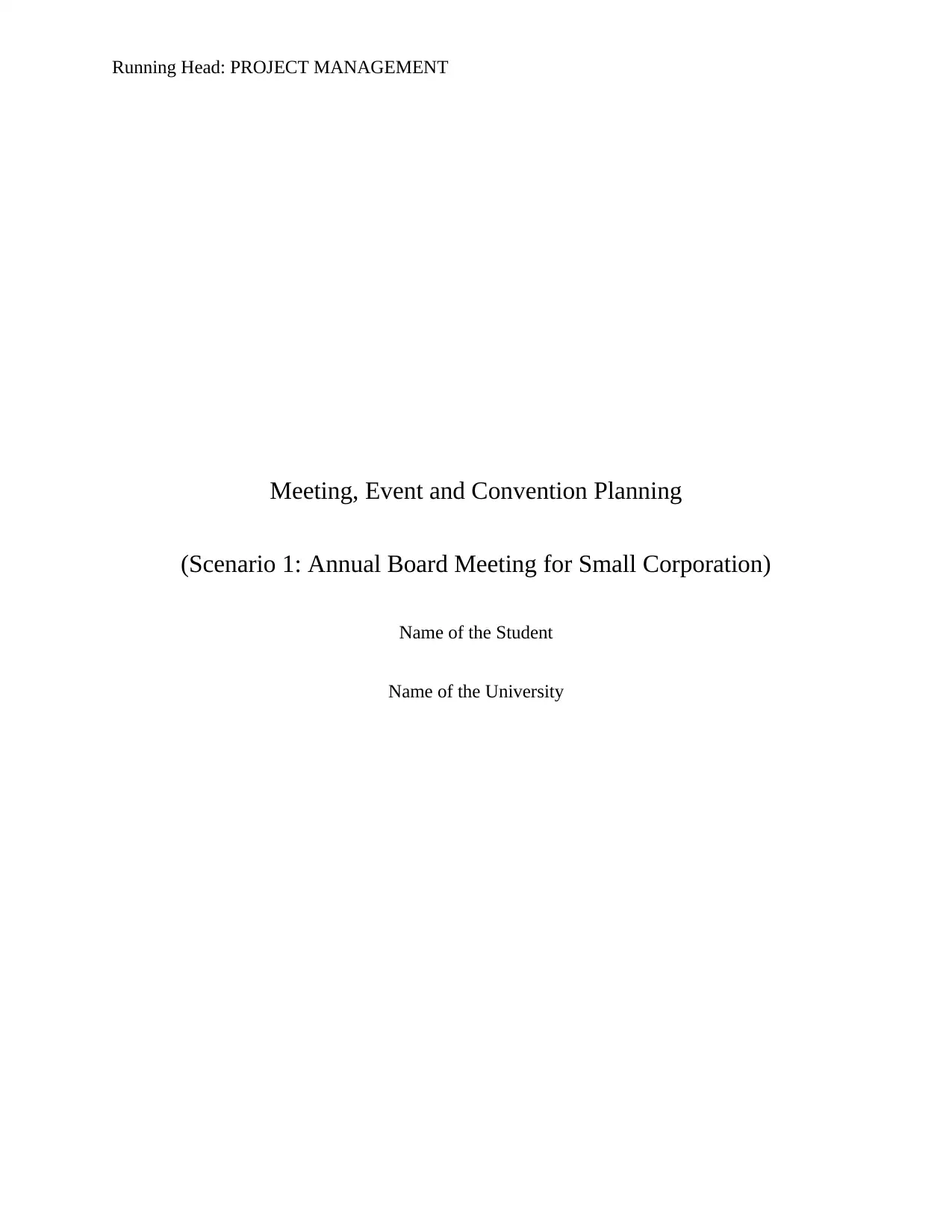
Running Head: PROJECT MANAGEMENT
Meeting, Event and Convention Planning
(Scenario 1: Annual Board Meeting for Small Corporation)
Name of the Student
Name of the University
Meeting, Event and Convention Planning
(Scenario 1: Annual Board Meeting for Small Corporation)
Name of the Student
Name of the University
Secure Best Marks with AI Grader
Need help grading? Try our AI Grader for instant feedback on your assignments.
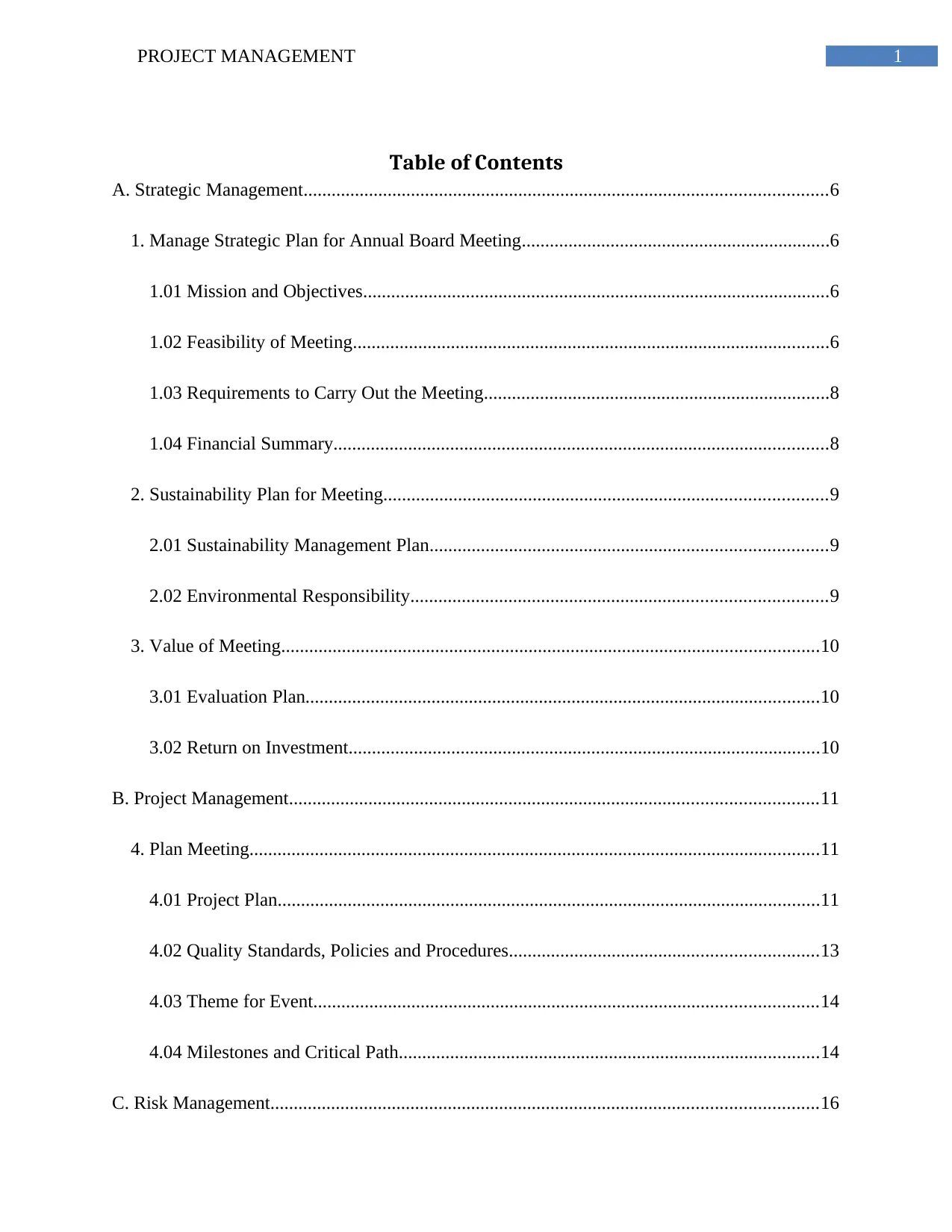
1PROJECT MANAGEMENT
Table of Contents
A. Strategic Management................................................................................................................6
1. Manage Strategic Plan for Annual Board Meeting..................................................................6
1.01 Mission and Objectives....................................................................................................6
1.02 Feasibility of Meeting......................................................................................................6
1.03 Requirements to Carry Out the Meeting..........................................................................8
1.04 Financial Summary..........................................................................................................8
2. Sustainability Plan for Meeting...............................................................................................9
2.01 Sustainability Management Plan.....................................................................................9
2.02 Environmental Responsibility.........................................................................................9
3. Value of Meeting...................................................................................................................10
3.01 Evaluation Plan..............................................................................................................10
3.02 Return on Investment.....................................................................................................10
B. Project Management.................................................................................................................11
4. Plan Meeting..........................................................................................................................11
4.01 Project Plan....................................................................................................................11
4.02 Quality Standards, Policies and Procedures..................................................................13
4.03 Theme for Event............................................................................................................14
4.04 Milestones and Critical Path..........................................................................................14
C. Risk Management.....................................................................................................................16
Table of Contents
A. Strategic Management................................................................................................................6
1. Manage Strategic Plan for Annual Board Meeting..................................................................6
1.01 Mission and Objectives....................................................................................................6
1.02 Feasibility of Meeting......................................................................................................6
1.03 Requirements to Carry Out the Meeting..........................................................................8
1.04 Financial Summary..........................................................................................................8
2. Sustainability Plan for Meeting...............................................................................................9
2.01 Sustainability Management Plan.....................................................................................9
2.02 Environmental Responsibility.........................................................................................9
3. Value of Meeting...................................................................................................................10
3.01 Evaluation Plan..............................................................................................................10
3.02 Return on Investment.....................................................................................................10
B. Project Management.................................................................................................................11
4. Plan Meeting..........................................................................................................................11
4.01 Project Plan....................................................................................................................11
4.02 Quality Standards, Policies and Procedures..................................................................13
4.03 Theme for Event............................................................................................................14
4.04 Milestones and Critical Path..........................................................................................14
C. Risk Management.....................................................................................................................16
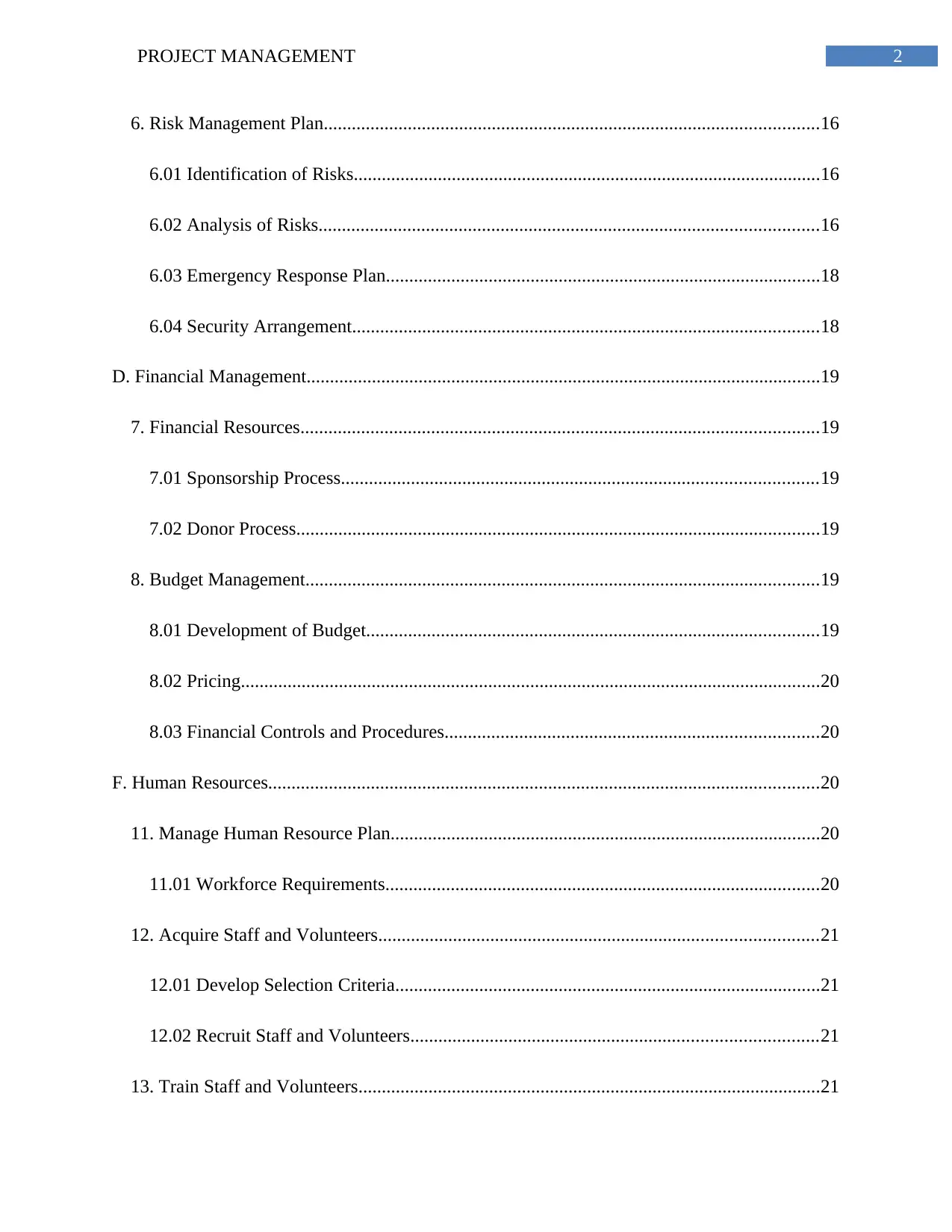
2PROJECT MANAGEMENT
6. Risk Management Plan..........................................................................................................16
6.01 Identification of Risks....................................................................................................16
6.02 Analysis of Risks...........................................................................................................16
6.03 Emergency Response Plan.............................................................................................18
6.04 Security Arrangement....................................................................................................18
D. Financial Management..............................................................................................................19
7. Financial Resources...............................................................................................................19
7.01 Sponsorship Process......................................................................................................19
7.02 Donor Process................................................................................................................19
8. Budget Management..............................................................................................................19
8.01 Development of Budget.................................................................................................19
8.02 Pricing............................................................................................................................20
8.03 Financial Controls and Procedures................................................................................20
F. Human Resources......................................................................................................................20
11. Manage Human Resource Plan............................................................................................20
11.01 Workforce Requirements.............................................................................................20
12. Acquire Staff and Volunteers..............................................................................................21
12.01 Develop Selection Criteria...........................................................................................21
12.02 Recruit Staff and Volunteers.......................................................................................21
13. Train Staff and Volunteers...................................................................................................21
6. Risk Management Plan..........................................................................................................16
6.01 Identification of Risks....................................................................................................16
6.02 Analysis of Risks...........................................................................................................16
6.03 Emergency Response Plan.............................................................................................18
6.04 Security Arrangement....................................................................................................18
D. Financial Management..............................................................................................................19
7. Financial Resources...............................................................................................................19
7.01 Sponsorship Process......................................................................................................19
7.02 Donor Process................................................................................................................19
8. Budget Management..............................................................................................................19
8.01 Development of Budget.................................................................................................19
8.02 Pricing............................................................................................................................20
8.03 Financial Controls and Procedures................................................................................20
F. Human Resources......................................................................................................................20
11. Manage Human Resource Plan............................................................................................20
11.01 Workforce Requirements.............................................................................................20
12. Acquire Staff and Volunteers..............................................................................................21
12.01 Develop Selection Criteria...........................................................................................21
12.02 Recruit Staff and Volunteers.......................................................................................21
13. Train Staff and Volunteers...................................................................................................21
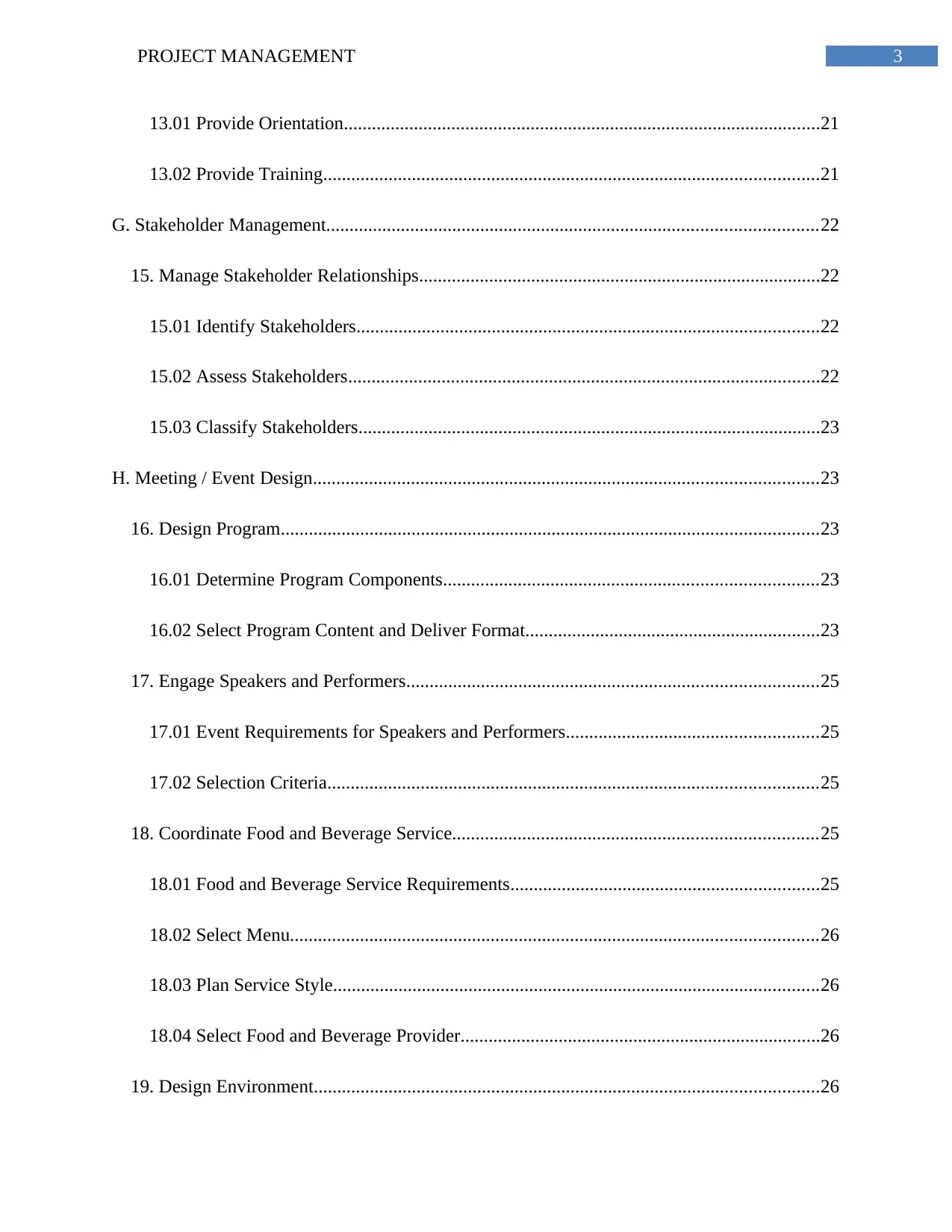
3PROJECT MANAGEMENT
13.01 Provide Orientation......................................................................................................21
13.02 Provide Training..........................................................................................................21
G. Stakeholder Management.........................................................................................................22
15. Manage Stakeholder Relationships......................................................................................22
15.01 Identify Stakeholders...................................................................................................22
15.02 Assess Stakeholders.....................................................................................................22
15.03 Classify Stakeholders...................................................................................................23
H. Meeting / Event Design............................................................................................................23
16. Design Program...................................................................................................................23
16.01 Determine Program Components................................................................................23
16.02 Select Program Content and Deliver Format...............................................................23
17. Engage Speakers and Performers........................................................................................25
17.01 Event Requirements for Speakers and Performers......................................................25
17.02 Selection Criteria.........................................................................................................25
18. Coordinate Food and Beverage Service..............................................................................25
18.01 Food and Beverage Service Requirements..................................................................25
18.02 Select Menu.................................................................................................................26
18.03 Plan Service Style........................................................................................................26
18.04 Select Food and Beverage Provider.............................................................................26
19. Design Environment............................................................................................................26
13.01 Provide Orientation......................................................................................................21
13.02 Provide Training..........................................................................................................21
G. Stakeholder Management.........................................................................................................22
15. Manage Stakeholder Relationships......................................................................................22
15.01 Identify Stakeholders...................................................................................................22
15.02 Assess Stakeholders.....................................................................................................22
15.03 Classify Stakeholders...................................................................................................23
H. Meeting / Event Design............................................................................................................23
16. Design Program...................................................................................................................23
16.01 Determine Program Components................................................................................23
16.02 Select Program Content and Deliver Format...............................................................23
17. Engage Speakers and Performers........................................................................................25
17.01 Event Requirements for Speakers and Performers......................................................25
17.02 Selection Criteria.........................................................................................................25
18. Coordinate Food and Beverage Service..............................................................................25
18.01 Food and Beverage Service Requirements..................................................................25
18.02 Select Menu.................................................................................................................26
18.03 Plan Service Style........................................................................................................26
18.04 Select Food and Beverage Provider.............................................................................26
19. Design Environment............................................................................................................26
Secure Best Marks with AI Grader
Need help grading? Try our AI Grader for instant feedback on your assignments.
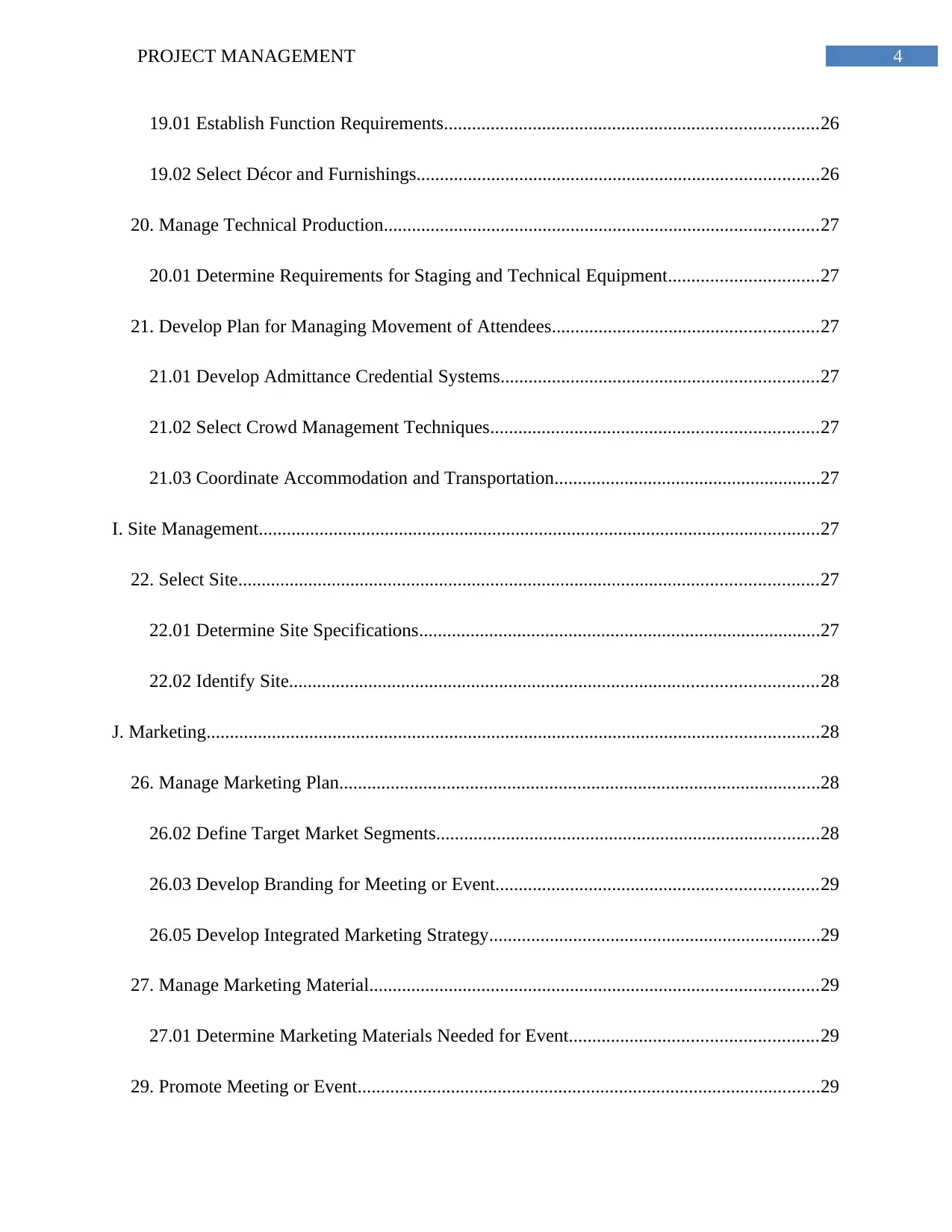
4PROJECT MANAGEMENT
19.01 Establish Function Requirements................................................................................26
19.02 Select Décor and Furnishings......................................................................................26
20. Manage Technical Production.............................................................................................27
20.01 Determine Requirements for Staging and Technical Equipment................................27
21. Develop Plan for Managing Movement of Attendees.........................................................27
21.01 Develop Admittance Credential Systems....................................................................27
21.02 Select Crowd Management Techniques......................................................................27
21.03 Coordinate Accommodation and Transportation.........................................................27
I. Site Management........................................................................................................................27
22. Select Site............................................................................................................................27
22.01 Determine Site Specifications......................................................................................27
22.02 Identify Site.................................................................................................................28
J. Marketing...................................................................................................................................28
26. Manage Marketing Plan.......................................................................................................28
26.02 Define Target Market Segments..................................................................................28
26.03 Develop Branding for Meeting or Event.....................................................................29
26.05 Develop Integrated Marketing Strategy.......................................................................29
27. Manage Marketing Material................................................................................................29
27.01 Determine Marketing Materials Needed for Event.....................................................29
29. Promote Meeting or Event...................................................................................................29
19.01 Establish Function Requirements................................................................................26
19.02 Select Décor and Furnishings......................................................................................26
20. Manage Technical Production.............................................................................................27
20.01 Determine Requirements for Staging and Technical Equipment................................27
21. Develop Plan for Managing Movement of Attendees.........................................................27
21.01 Develop Admittance Credential Systems....................................................................27
21.02 Select Crowd Management Techniques......................................................................27
21.03 Coordinate Accommodation and Transportation.........................................................27
I. Site Management........................................................................................................................27
22. Select Site............................................................................................................................27
22.01 Determine Site Specifications......................................................................................27
22.02 Identify Site.................................................................................................................28
J. Marketing...................................................................................................................................28
26. Manage Marketing Plan.......................................................................................................28
26.02 Define Target Market Segments..................................................................................28
26.03 Develop Branding for Meeting or Event.....................................................................29
26.05 Develop Integrated Marketing Strategy.......................................................................29
27. Manage Marketing Material................................................................................................29
27.01 Determine Marketing Materials Needed for Event.....................................................29
29. Promote Meeting or Event...................................................................................................29

5PROJECT MANAGEMENT
29.01 Develop Advertising Plan............................................................................................29
K. Professionalism.........................................................................................................................30
32. Exhibit Professional Behavior.............................................................................................30
32.01 Project a Professional Image.......................................................................................30
32.02 Demonstrate Leadership..............................................................................................30
32.03 Demonstrate Ethical Behavior.....................................................................................30
32.06 Manage Time...............................................................................................................30
32.07 Manage Stress..............................................................................................................30
References......................................................................................................................................32
29.01 Develop Advertising Plan............................................................................................29
K. Professionalism.........................................................................................................................30
32. Exhibit Professional Behavior.............................................................................................30
32.01 Project a Professional Image.......................................................................................30
32.02 Demonstrate Leadership..............................................................................................30
32.03 Demonstrate Ethical Behavior.....................................................................................30
32.06 Manage Time...............................................................................................................30
32.07 Manage Stress..............................................................................................................30
References......................................................................................................................................32

6PROJECT MANAGEMENT
A. Strategic Management
1. Manage Strategic Plan for Annual Board Meeting
1.01 Mission and Objectives
The main mission of the project is to conduct a casual but important board meeting
regarding the discussion of the results of the year-end business and financial statistics of the
company. The objectives of the meeting are presented in SMART format as follows
(Boshnakova & Goldblatt, 2016).
Specific: To discuss year end statistics and prepare next year’s business strategy
Measurable: To develop strategy to increase the revenue for next year by at least 25%
Acceptable: To use the previous year’s statistics to build the next plan that will be
acceptable for the company
Relevant: To prepare updated and relevant strategy for next year
Time Based: To conduct the meeting the entire day with several refreshment breaks
1.02 Feasibility of Meeting
Although the meeting is said to be casual, serious business discussions will be done
regarding the business strategy for the next year. The meeting will be attended by 25 board
members who will discuss the strategies among themselves. The meeting is feasible as it is not a
very highly scoped event and the members will only discuss the points using some of previous
A. Strategic Management
1. Manage Strategic Plan for Annual Board Meeting
1.01 Mission and Objectives
The main mission of the project is to conduct a casual but important board meeting
regarding the discussion of the results of the year-end business and financial statistics of the
company. The objectives of the meeting are presented in SMART format as follows
(Boshnakova & Goldblatt, 2016).
Specific: To discuss year end statistics and prepare next year’s business strategy
Measurable: To develop strategy to increase the revenue for next year by at least 25%
Acceptable: To use the previous year’s statistics to build the next plan that will be
acceptable for the company
Relevant: To prepare updated and relevant strategy for next year
Time Based: To conduct the meeting the entire day with several refreshment breaks
1.02 Feasibility of Meeting
Although the meeting is said to be casual, serious business discussions will be done
regarding the business strategy for the next year. The meeting will be attended by 25 board
members who will discuss the strategies among themselves. The meeting is feasible as it is not a
very highly scoped event and the members will only discuss the points using some of previous
Paraphrase This Document
Need a fresh take? Get an instant paraphrase of this document with our AI Paraphraser
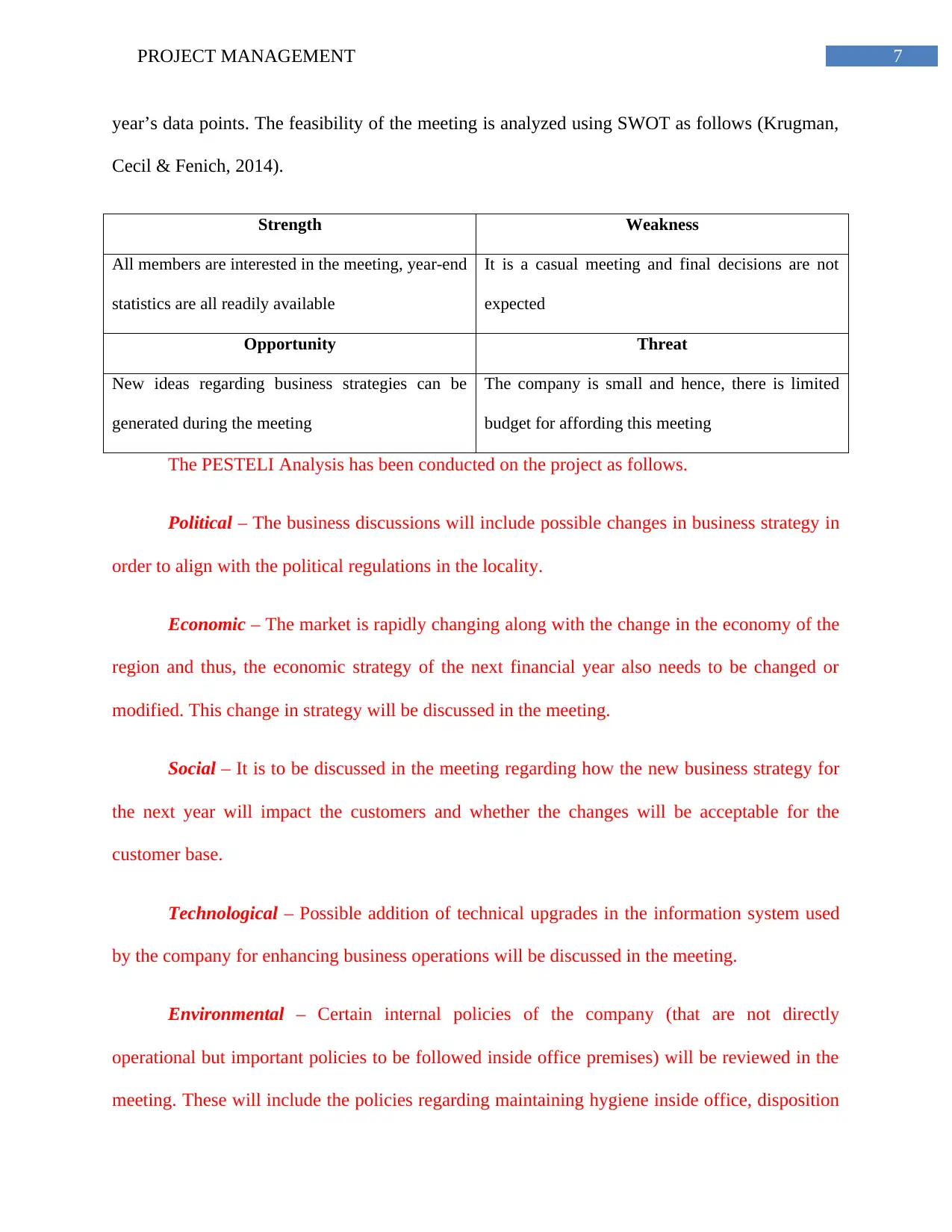
7PROJECT MANAGEMENT
year’s data points. The feasibility of the meeting is analyzed using SWOT as follows (Krugman,
Cecil & Fenich, 2014).
Strength Weakness
All members are interested in the meeting, year-end
statistics are all readily available
It is a casual meeting and final decisions are not
expected
Opportunity Threat
New ideas regarding business strategies can be
generated during the meeting
The company is small and hence, there is limited
budget for affording this meeting
The PESTELI Analysis has been conducted on the project as follows.
Political – The business discussions will include possible changes in business strategy in
order to align with the political regulations in the locality.
Economic – The market is rapidly changing along with the change in the economy of the
region and thus, the economic strategy of the next financial year also needs to be changed or
modified. This change in strategy will be discussed in the meeting.
Social – It is to be discussed in the meeting regarding how the new business strategy for
the next year will impact the customers and whether the changes will be acceptable for the
customer base.
Technological – Possible addition of technical upgrades in the information system used
by the company for enhancing business operations will be discussed in the meeting.
Environmental – Certain internal policies of the company (that are not directly
operational but important policies to be followed inside office premises) will be reviewed in the
meeting. These will include the policies regarding maintaining hygiene inside office, disposition
year’s data points. The feasibility of the meeting is analyzed using SWOT as follows (Krugman,
Cecil & Fenich, 2014).
Strength Weakness
All members are interested in the meeting, year-end
statistics are all readily available
It is a casual meeting and final decisions are not
expected
Opportunity Threat
New ideas regarding business strategies can be
generated during the meeting
The company is small and hence, there is limited
budget for affording this meeting
The PESTELI Analysis has been conducted on the project as follows.
Political – The business discussions will include possible changes in business strategy in
order to align with the political regulations in the locality.
Economic – The market is rapidly changing along with the change in the economy of the
region and thus, the economic strategy of the next financial year also needs to be changed or
modified. This change in strategy will be discussed in the meeting.
Social – It is to be discussed in the meeting regarding how the new business strategy for
the next year will impact the customers and whether the changes will be acceptable for the
customer base.
Technological – Possible addition of technical upgrades in the information system used
by the company for enhancing business operations will be discussed in the meeting.
Environmental – Certain internal policies of the company (that are not directly
operational but important policies to be followed inside office premises) will be reviewed in the
meeting. These will include the policies regarding maintaining hygiene inside office, disposition

8PROJECT MANAGEMENT
of coffee cups and food plates at proper places and others in order to ensure the negative impact
on the environment is minimized.
Legal – The changing legal guidelines regarding business will be discussed and the
current compliance with the legal frameworks will be reviewed.
Industry – The changes in the current industry will be reviewed before developing new
business strategies for the next operational year.
1.03 Requirements to Carry Out the Meeting
The main requirements for carrying out the meeting include year-end statistics and
previous years’ data points. These statistics will be the focal points of the discussion and
strategies will be developed to improve the statistics further.
1.04 Financial Summary
The financial summary for the meeting is shown in the following table.
Resource Cost
Conference Center Rent $2000
Name Badges $250
Audio-Visual Devices Rent $1250
Set Up Requirements $250
Food and Drinks $2500
Other Costs $500
TOTAL $6750
of coffee cups and food plates at proper places and others in order to ensure the negative impact
on the environment is minimized.
Legal – The changing legal guidelines regarding business will be discussed and the
current compliance with the legal frameworks will be reviewed.
Industry – The changes in the current industry will be reviewed before developing new
business strategies for the next operational year.
1.03 Requirements to Carry Out the Meeting
The main requirements for carrying out the meeting include year-end statistics and
previous years’ data points. These statistics will be the focal points of the discussion and
strategies will be developed to improve the statistics further.
1.04 Financial Summary
The financial summary for the meeting is shown in the following table.
Resource Cost
Conference Center Rent $2000
Name Badges $250
Audio-Visual Devices Rent $1250
Set Up Requirements $250
Food and Drinks $2500
Other Costs $500
TOTAL $6750
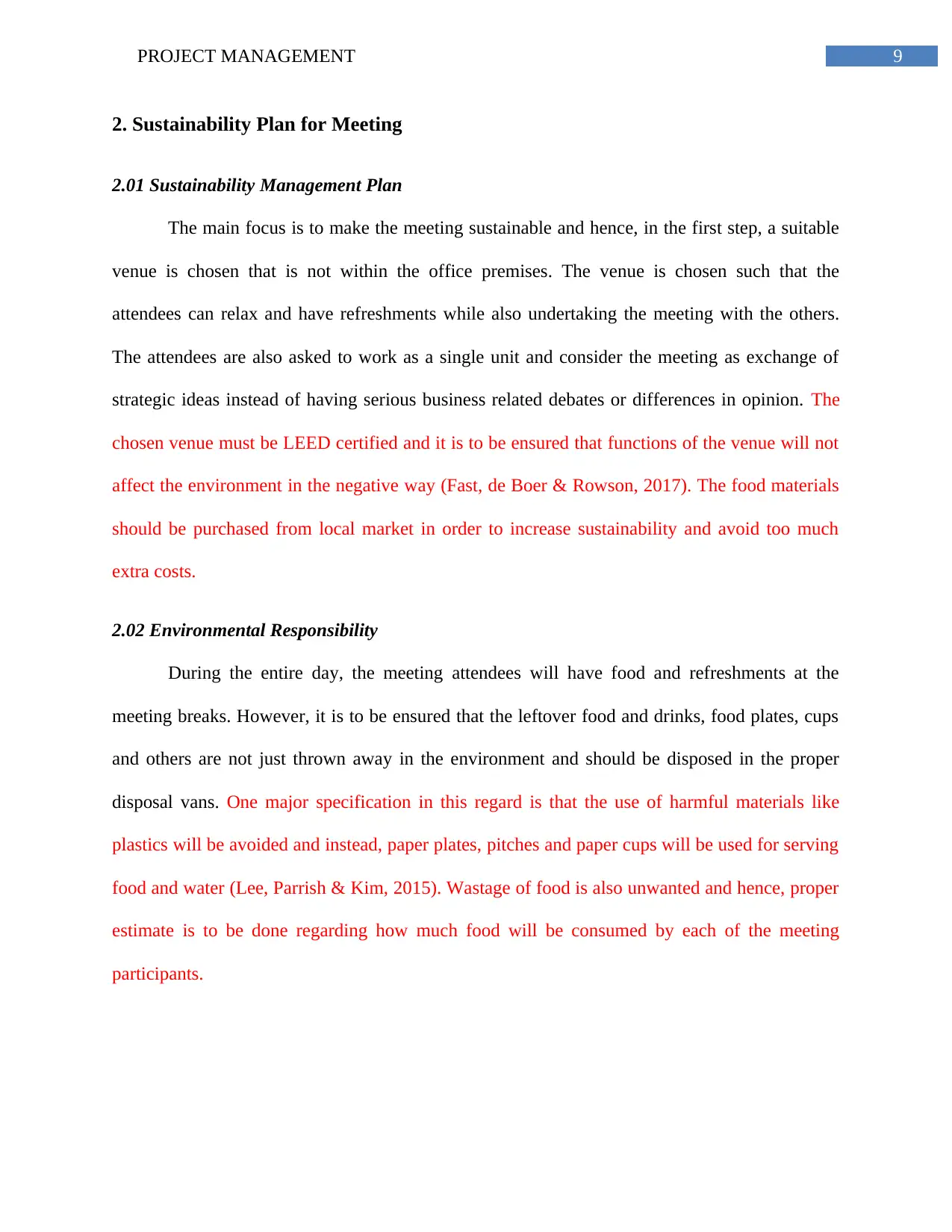
9PROJECT MANAGEMENT
2. Sustainability Plan for Meeting
2.01 Sustainability Management Plan
The main focus is to make the meeting sustainable and hence, in the first step, a suitable
venue is chosen that is not within the office premises. The venue is chosen such that the
attendees can relax and have refreshments while also undertaking the meeting with the others.
The attendees are also asked to work as a single unit and consider the meeting as exchange of
strategic ideas instead of having serious business related debates or differences in opinion. The
chosen venue must be LEED certified and it is to be ensured that functions of the venue will not
affect the environment in the negative way (Fast, de Boer & Rowson, 2017). The food materials
should be purchased from local market in order to increase sustainability and avoid too much
extra costs.
2.02 Environmental Responsibility
During the entire day, the meeting attendees will have food and refreshments at the
meeting breaks. However, it is to be ensured that the leftover food and drinks, food plates, cups
and others are not just thrown away in the environment and should be disposed in the proper
disposal vans. One major specification in this regard is that the use of harmful materials like
plastics will be avoided and instead, paper plates, pitches and paper cups will be used for serving
food and water (Lee, Parrish & Kim, 2015). Wastage of food is also unwanted and hence, proper
estimate is to be done regarding how much food will be consumed by each of the meeting
participants.
2. Sustainability Plan for Meeting
2.01 Sustainability Management Plan
The main focus is to make the meeting sustainable and hence, in the first step, a suitable
venue is chosen that is not within the office premises. The venue is chosen such that the
attendees can relax and have refreshments while also undertaking the meeting with the others.
The attendees are also asked to work as a single unit and consider the meeting as exchange of
strategic ideas instead of having serious business related debates or differences in opinion. The
chosen venue must be LEED certified and it is to be ensured that functions of the venue will not
affect the environment in the negative way (Fast, de Boer & Rowson, 2017). The food materials
should be purchased from local market in order to increase sustainability and avoid too much
extra costs.
2.02 Environmental Responsibility
During the entire day, the meeting attendees will have food and refreshments at the
meeting breaks. However, it is to be ensured that the leftover food and drinks, food plates, cups
and others are not just thrown away in the environment and should be disposed in the proper
disposal vans. One major specification in this regard is that the use of harmful materials like
plastics will be avoided and instead, paper plates, pitches and paper cups will be used for serving
food and water (Lee, Parrish & Kim, 2015). Wastage of food is also unwanted and hence, proper
estimate is to be done regarding how much food will be consumed by each of the meeting
participants.
Secure Best Marks with AI Grader
Need help grading? Try our AI Grader for instant feedback on your assignments.

10PROJECT MANAGEMENT
3. Value of Meeting
3.01 Evaluation Plan
The outcome of the meeting will be evaluated by the decisions made at the end of the
meeting. The ideas generated and proposed new strategies will be evaluated based on their
feasibility of implementation in the business. The ideas will be evaluated by the company
director and will be incorporated within the business plan if they are found to be feasible,
reasonable and valid.
3.02 Return on Investment
There is no direct monetary return on investment from this meeting. However, the ideas
generated in the meeting will help to enhance the business strategy of the company and thus, the
meeting may pave the way for long term benefits for the company.
Regarding return on objectives (non-financial benefits), it is important that all members
of the board attend the meeting. This is because this meeting focuses on ideas generated by all
members regarding new business strategy (Cecil, Fenich, Krugman & Hashimoto, 2013).
Furthermore, this meeting also desires to acknowledge all the board members that each and
every one of them is equally important in the operations of the company.
3. Value of Meeting
3.01 Evaluation Plan
The outcome of the meeting will be evaluated by the decisions made at the end of the
meeting. The ideas generated and proposed new strategies will be evaluated based on their
feasibility of implementation in the business. The ideas will be evaluated by the company
director and will be incorporated within the business plan if they are found to be feasible,
reasonable and valid.
3.02 Return on Investment
There is no direct monetary return on investment from this meeting. However, the ideas
generated in the meeting will help to enhance the business strategy of the company and thus, the
meeting may pave the way for long term benefits for the company.
Regarding return on objectives (non-financial benefits), it is important that all members
of the board attend the meeting. This is because this meeting focuses on ideas generated by all
members regarding new business strategy (Cecil, Fenich, Krugman & Hashimoto, 2013).
Furthermore, this meeting also desires to acknowledge all the board members that each and
every one of them is equally important in the operations of the company.
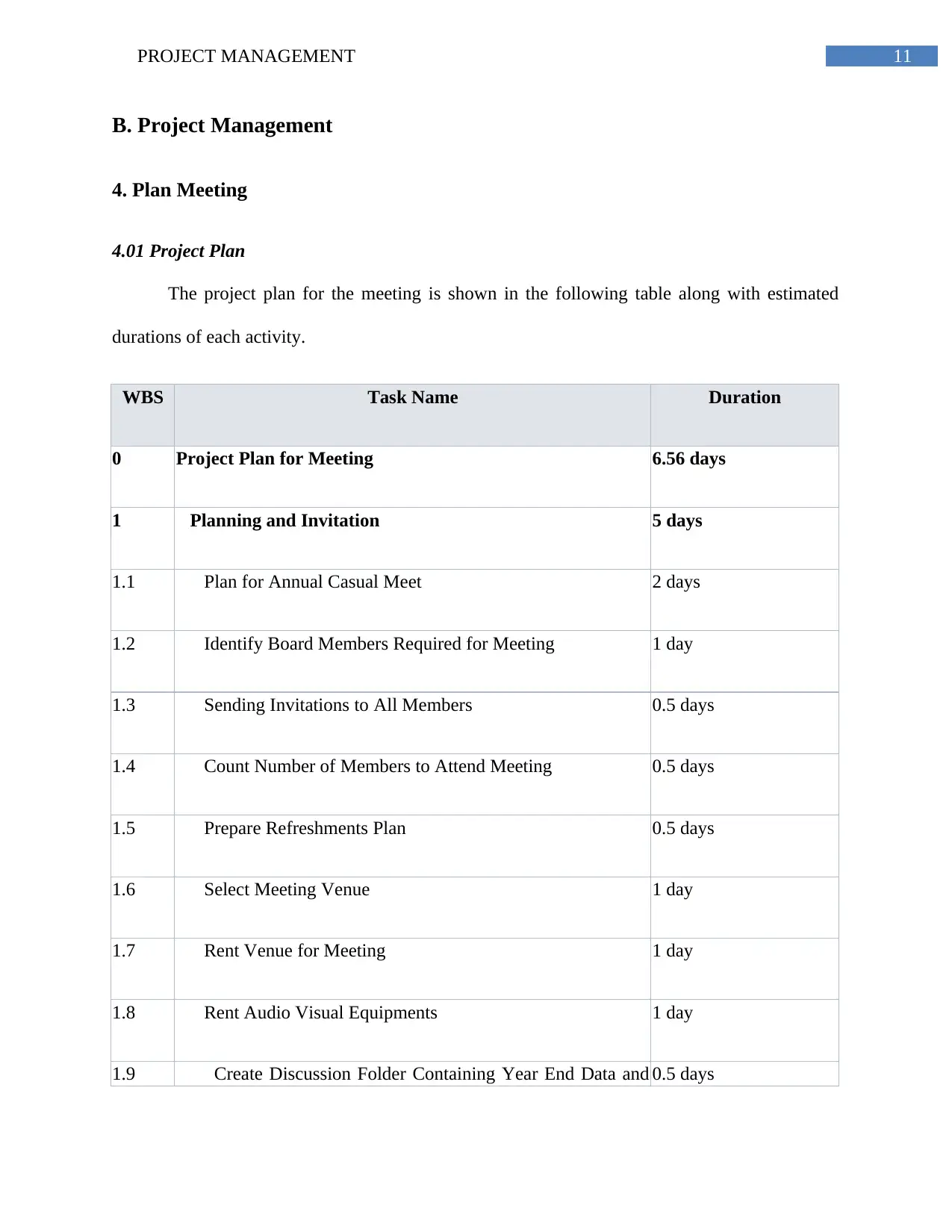
11PROJECT MANAGEMENT
B. Project Management
4. Plan Meeting
4.01 Project Plan
The project plan for the meeting is shown in the following table along with estimated
durations of each activity.
WBS Task Name Duration
0 Project Plan for Meeting 6.56 days
1 Planning and Invitation 5 days
1.1 Plan for Annual Casual Meet 2 days
1.2 Identify Board Members Required for Meeting 1 day
1.3 Sending Invitations to All Members 0.5 days
1.4 Count Number of Members to Attend Meeting 0.5 days
1.5 Prepare Refreshments Plan 0.5 days
1.6 Select Meeting Venue 1 day
1.7 Rent Venue for Meeting 1 day
1.8 Rent Audio Visual Equipments 1 day
1.9 Create Discussion Folder Containing Year End Data and 0.5 days
B. Project Management
4. Plan Meeting
4.01 Project Plan
The project plan for the meeting is shown in the following table along with estimated
durations of each activity.
WBS Task Name Duration
0 Project Plan for Meeting 6.56 days
1 Planning and Invitation 5 days
1.1 Plan for Annual Casual Meet 2 days
1.2 Identify Board Members Required for Meeting 1 day
1.3 Sending Invitations to All Members 0.5 days
1.4 Count Number of Members to Attend Meeting 0.5 days
1.5 Prepare Refreshments Plan 0.5 days
1.6 Select Meeting Venue 1 day
1.7 Rent Venue for Meeting 1 day
1.8 Rent Audio Visual Equipments 1 day
1.9 Create Discussion Folder Containing Year End Data and 0.5 days
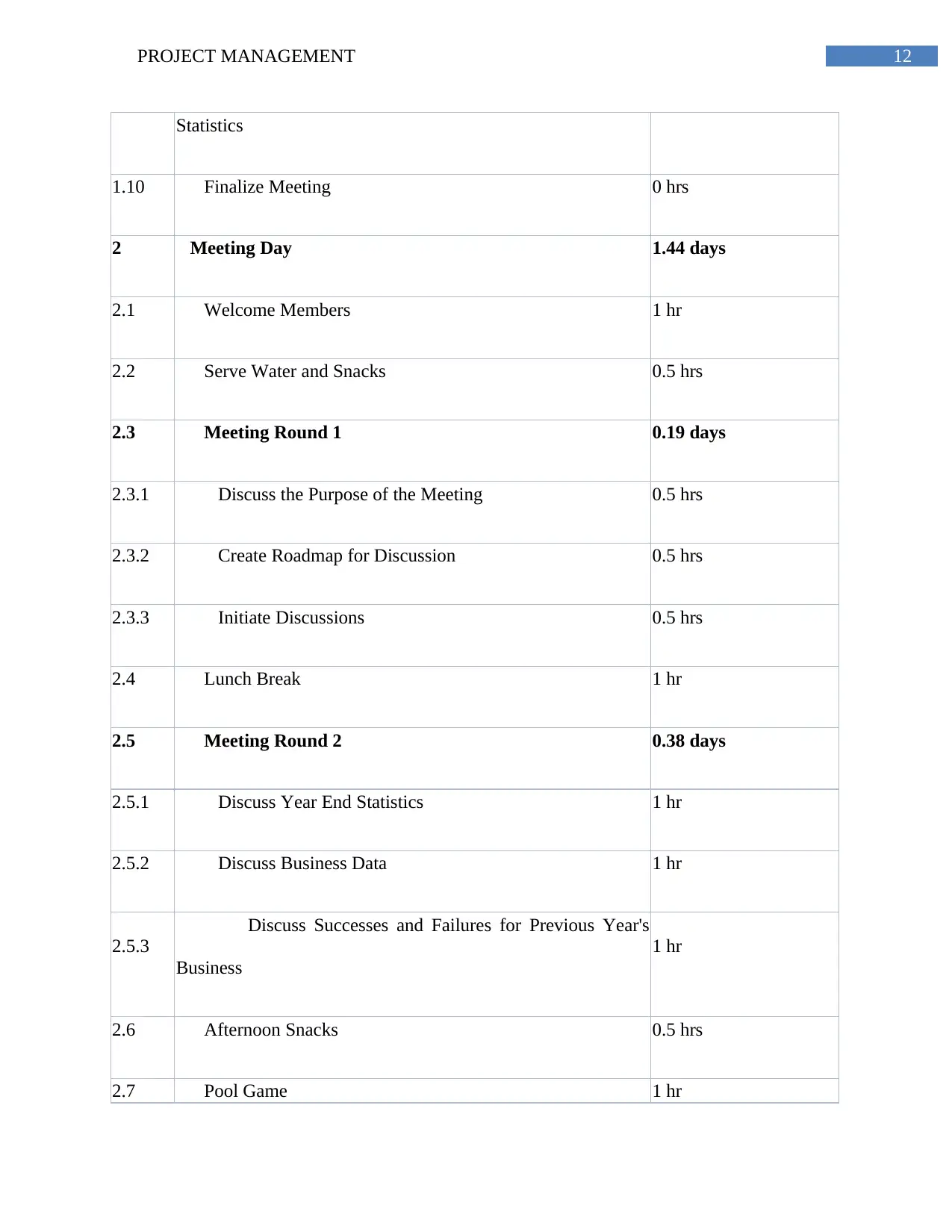
12PROJECT MANAGEMENT
Statistics
1.10 Finalize Meeting 0 hrs
2 Meeting Day 1.44 days
2.1 Welcome Members 1 hr
2.2 Serve Water and Snacks 0.5 hrs
2.3 Meeting Round 1 0.19 days
2.3.1 Discuss the Purpose of the Meeting 0.5 hrs
2.3.2 Create Roadmap for Discussion 0.5 hrs
2.3.3 Initiate Discussions 0.5 hrs
2.4 Lunch Break 1 hr
2.5 Meeting Round 2 0.38 days
2.5.1 Discuss Year End Statistics 1 hr
2.5.2 Discuss Business Data 1 hr
2.5.3
Discuss Successes and Failures for Previous Year's
Business
1 hr
2.6 Afternoon Snacks 0.5 hrs
2.7 Pool Game 1 hr
Statistics
1.10 Finalize Meeting 0 hrs
2 Meeting Day 1.44 days
2.1 Welcome Members 1 hr
2.2 Serve Water and Snacks 0.5 hrs
2.3 Meeting Round 1 0.19 days
2.3.1 Discuss the Purpose of the Meeting 0.5 hrs
2.3.2 Create Roadmap for Discussion 0.5 hrs
2.3.3 Initiate Discussions 0.5 hrs
2.4 Lunch Break 1 hr
2.5 Meeting Round 2 0.38 days
2.5.1 Discuss Year End Statistics 1 hr
2.5.2 Discuss Business Data 1 hr
2.5.3
Discuss Successes and Failures for Previous Year's
Business
1 hr
2.6 Afternoon Snacks 0.5 hrs
2.7 Pool Game 1 hr
Paraphrase This Document
Need a fresh take? Get an instant paraphrase of this document with our AI Paraphraser

13PROJECT MANAGEMENT
2.8 Meeting Round 3 0.31 days
2.8.1 Discuss Business Strategy for Next Year 1 hr
2.8.2 Develop New Ideas and Plans 1 hr
2.8.3 Documentation and Finishing Meeting 0.5 hrs
2.9 Light Music, Drinks and Casual Enjoyment 0.5 hrs
2.10 Dinner 0.5 hrs
3 Finishing Work 0.13 days
3.1 Greet Good Night to the Guests 0.5 hrs
3.2 Cleaning Up the Venue 0.5 hrs
3.3 Closing 0 days
4.02 Quality Standards, Policies and Procedures
During the meeting, there will be several topics of business that has to be discussed.
While generating ideas and discussing the topics, the participants have to keep in mind the
quality standards that are required for the business. Moreover, the focus of the new ideas will be
to raise the quality standards of the business strategies in order to enhance the overall
performance of the business.
2.8 Meeting Round 3 0.31 days
2.8.1 Discuss Business Strategy for Next Year 1 hr
2.8.2 Develop New Ideas and Plans 1 hr
2.8.3 Documentation and Finishing Meeting 0.5 hrs
2.9 Light Music, Drinks and Casual Enjoyment 0.5 hrs
2.10 Dinner 0.5 hrs
3 Finishing Work 0.13 days
3.1 Greet Good Night to the Guests 0.5 hrs
3.2 Cleaning Up the Venue 0.5 hrs
3.3 Closing 0 days
4.02 Quality Standards, Policies and Procedures
During the meeting, there will be several topics of business that has to be discussed.
While generating ideas and discussing the topics, the participants have to keep in mind the
quality standards that are required for the business. Moreover, the focus of the new ideas will be
to raise the quality standards of the business strategies in order to enhance the overall
performance of the business.
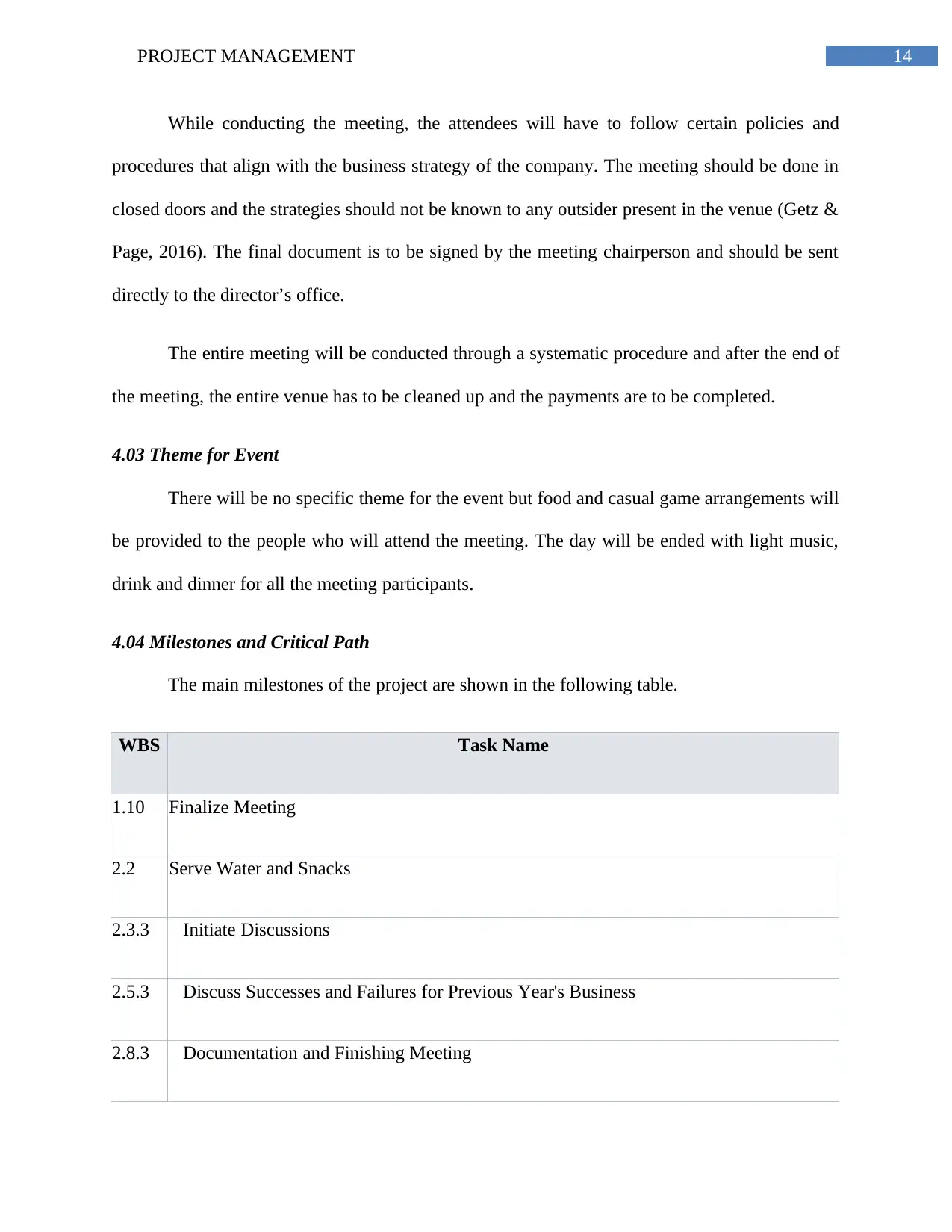
14PROJECT MANAGEMENT
While conducting the meeting, the attendees will have to follow certain policies and
procedures that align with the business strategy of the company. The meeting should be done in
closed doors and the strategies should not be known to any outsider present in the venue (Getz &
Page, 2016). The final document is to be signed by the meeting chairperson and should be sent
directly to the director’s office.
The entire meeting will be conducted through a systematic procedure and after the end of
the meeting, the entire venue has to be cleaned up and the payments are to be completed.
4.03 Theme for Event
There will be no specific theme for the event but food and casual game arrangements will
be provided to the people who will attend the meeting. The day will be ended with light music,
drink and dinner for all the meeting participants.
4.04 Milestones and Critical Path
The main milestones of the project are shown in the following table.
WBS Task Name
1.10 Finalize Meeting
2.2 Serve Water and Snacks
2.3.3 Initiate Discussions
2.5.3 Discuss Successes and Failures for Previous Year's Business
2.8.3 Documentation and Finishing Meeting
While conducting the meeting, the attendees will have to follow certain policies and
procedures that align with the business strategy of the company. The meeting should be done in
closed doors and the strategies should not be known to any outsider present in the venue (Getz &
Page, 2016). The final document is to be signed by the meeting chairperson and should be sent
directly to the director’s office.
The entire meeting will be conducted through a systematic procedure and after the end of
the meeting, the entire venue has to be cleaned up and the payments are to be completed.
4.03 Theme for Event
There will be no specific theme for the event but food and casual game arrangements will
be provided to the people who will attend the meeting. The day will be ended with light music,
drink and dinner for all the meeting participants.
4.04 Milestones and Critical Path
The main milestones of the project are shown in the following table.
WBS Task Name
1.10 Finalize Meeting
2.2 Serve Water and Snacks
2.3.3 Initiate Discussions
2.5.3 Discuss Successes and Failures for Previous Year's Business
2.8.3 Documentation and Finishing Meeting

15PROJECT MANAGEMENT
3.3 Closing
The critical path is shown in the following Gantt chart (the critical path is marked in red).
Figure 1: Gantt Chart and Critical Path
(Source: Created by Author)
3.3 Closing
The critical path is shown in the following Gantt chart (the critical path is marked in red).
Figure 1: Gantt Chart and Critical Path
(Source: Created by Author)
Secure Best Marks with AI Grader
Need help grading? Try our AI Grader for instant feedback on your assignments.
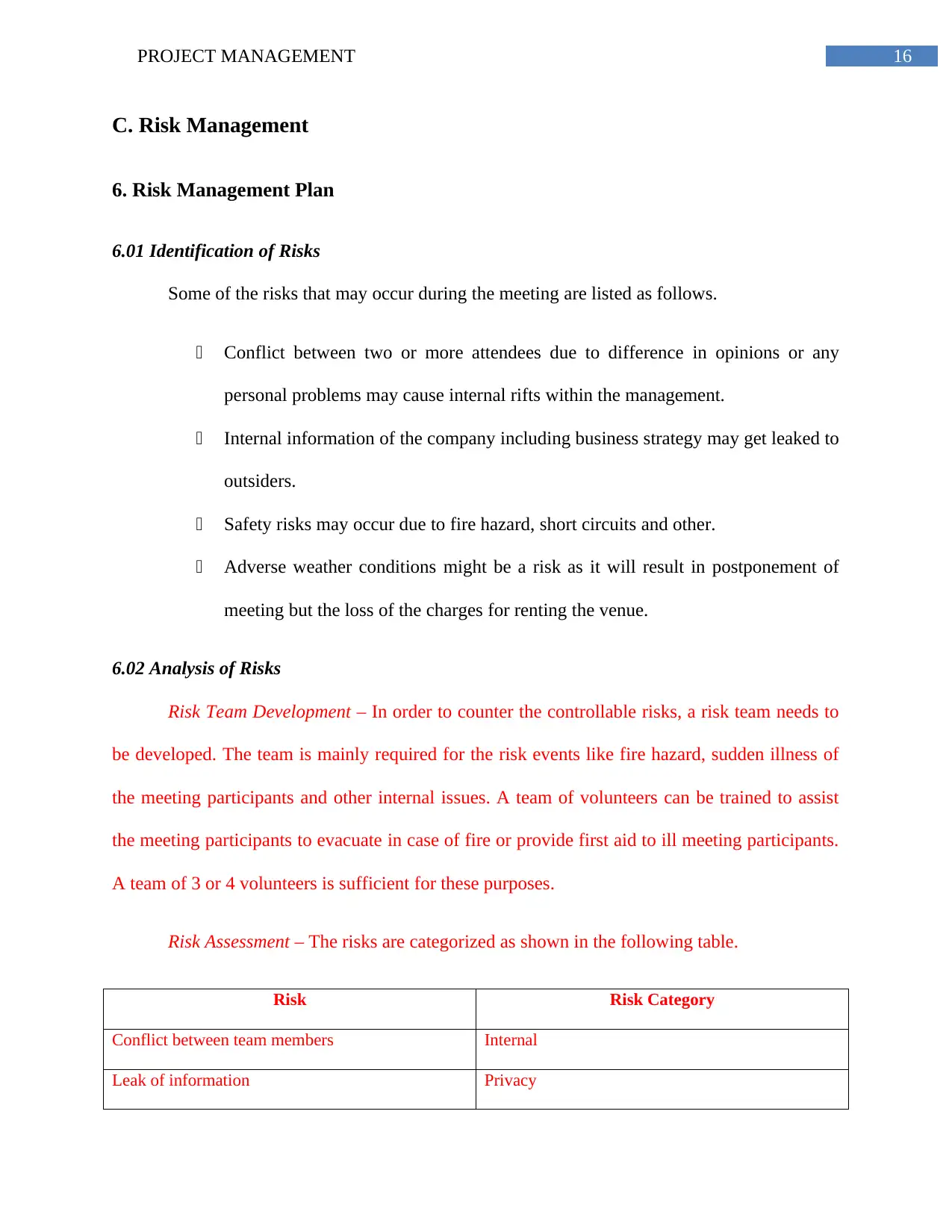
16PROJECT MANAGEMENT
C. Risk Management
6. Risk Management Plan
6.01 Identification of Risks
Some of the risks that may occur during the meeting are listed as follows.
Conflict between two or more attendees due to difference in opinions or any
personal problems may cause internal rifts within the management.
Internal information of the company including business strategy may get leaked to
outsiders.
Safety risks may occur due to fire hazard, short circuits and other.
Adverse weather conditions might be a risk as it will result in postponement of
meeting but the loss of the charges for renting the venue.
6.02 Analysis of Risks
Risk Team Development – In order to counter the controllable risks, a risk team needs to
be developed. The team is mainly required for the risk events like fire hazard, sudden illness of
the meeting participants and other internal issues. A team of volunteers can be trained to assist
the meeting participants to evacuate in case of fire or provide first aid to ill meeting participants.
A team of 3 or 4 volunteers is sufficient for these purposes.
Risk Assessment – The risks are categorized as shown in the following table.
Risk Risk Category
Conflict between team members Internal
Leak of information Privacy
C. Risk Management
6. Risk Management Plan
6.01 Identification of Risks
Some of the risks that may occur during the meeting are listed as follows.
Conflict between two or more attendees due to difference in opinions or any
personal problems may cause internal rifts within the management.
Internal information of the company including business strategy may get leaked to
outsiders.
Safety risks may occur due to fire hazard, short circuits and other.
Adverse weather conditions might be a risk as it will result in postponement of
meeting but the loss of the charges for renting the venue.
6.02 Analysis of Risks
Risk Team Development – In order to counter the controllable risks, a risk team needs to
be developed. The team is mainly required for the risk events like fire hazard, sudden illness of
the meeting participants and other internal issues. A team of volunteers can be trained to assist
the meeting participants to evacuate in case of fire or provide first aid to ill meeting participants.
A team of 3 or 4 volunteers is sufficient for these purposes.
Risk Assessment – The risks are categorized as shown in the following table.
Risk Risk Category
Conflict between team members Internal
Leak of information Privacy
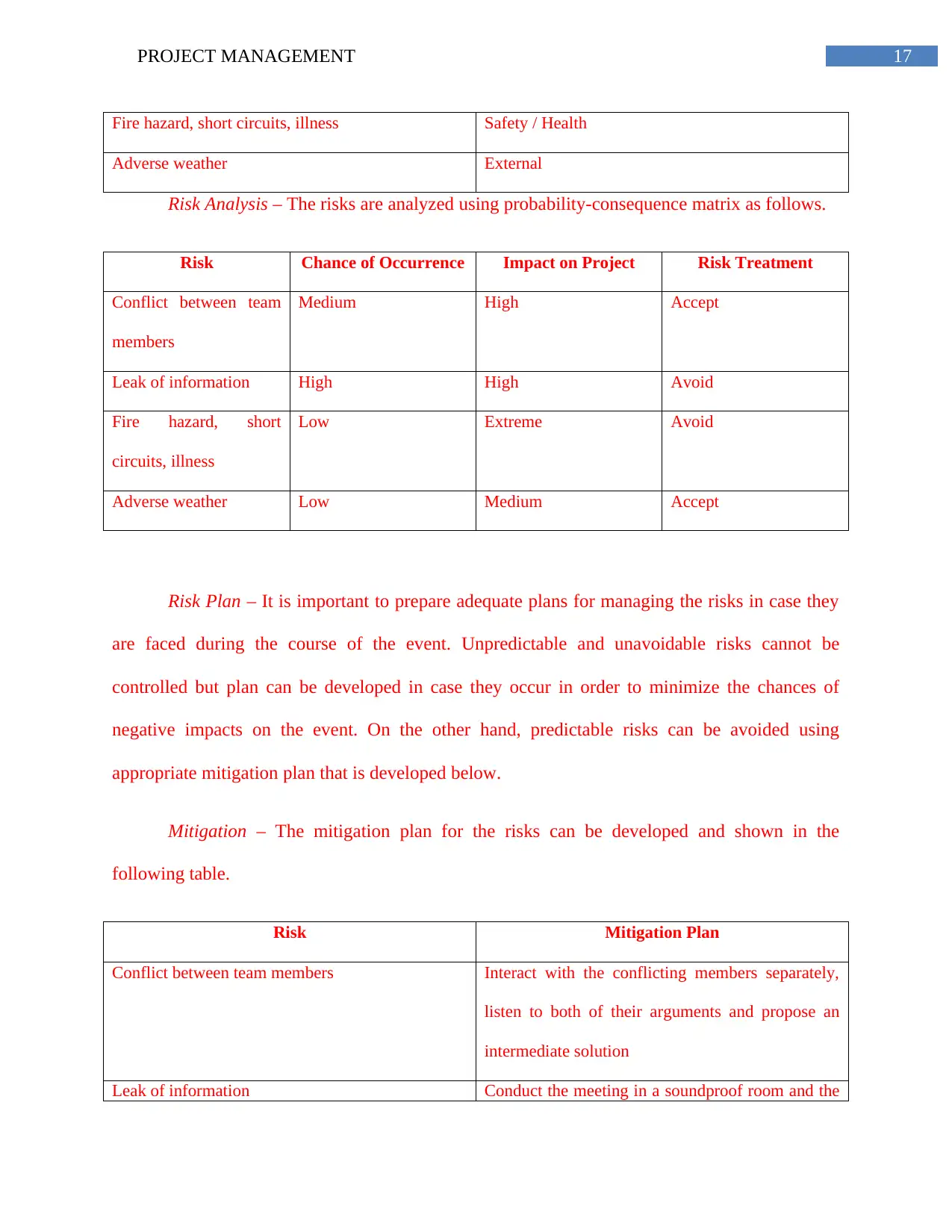
17PROJECT MANAGEMENT
Fire hazard, short circuits, illness Safety / Health
Adverse weather External
Risk Analysis – The risks are analyzed using probability-consequence matrix as follows.
Risk Chance of Occurrence Impact on Project Risk Treatment
Conflict between team
members
Medium High Accept
Leak of information High High Avoid
Fire hazard, short
circuits, illness
Low Extreme Avoid
Adverse weather Low Medium Accept
Risk Plan – It is important to prepare adequate plans for managing the risks in case they
are faced during the course of the event. Unpredictable and unavoidable risks cannot be
controlled but plan can be developed in case they occur in order to minimize the chances of
negative impacts on the event. On the other hand, predictable risks can be avoided using
appropriate mitigation plan that is developed below.
Mitigation – The mitigation plan for the risks can be developed and shown in the
following table.
Risk Mitigation Plan
Conflict between team members Interact with the conflicting members separately,
listen to both of their arguments and propose an
intermediate solution
Leak of information Conduct the meeting in a soundproof room and the
Fire hazard, short circuits, illness Safety / Health
Adverse weather External
Risk Analysis – The risks are analyzed using probability-consequence matrix as follows.
Risk Chance of Occurrence Impact on Project Risk Treatment
Conflict between team
members
Medium High Accept
Leak of information High High Avoid
Fire hazard, short
circuits, illness
Low Extreme Avoid
Adverse weather Low Medium Accept
Risk Plan – It is important to prepare adequate plans for managing the risks in case they
are faced during the course of the event. Unpredictable and unavoidable risks cannot be
controlled but plan can be developed in case they occur in order to minimize the chances of
negative impacts on the event. On the other hand, predictable risks can be avoided using
appropriate mitigation plan that is developed below.
Mitigation – The mitigation plan for the risks can be developed and shown in the
following table.
Risk Mitigation Plan
Conflict between team members Interact with the conflicting members separately,
listen to both of their arguments and propose an
intermediate solution
Leak of information Conduct the meeting in a soundproof room and the
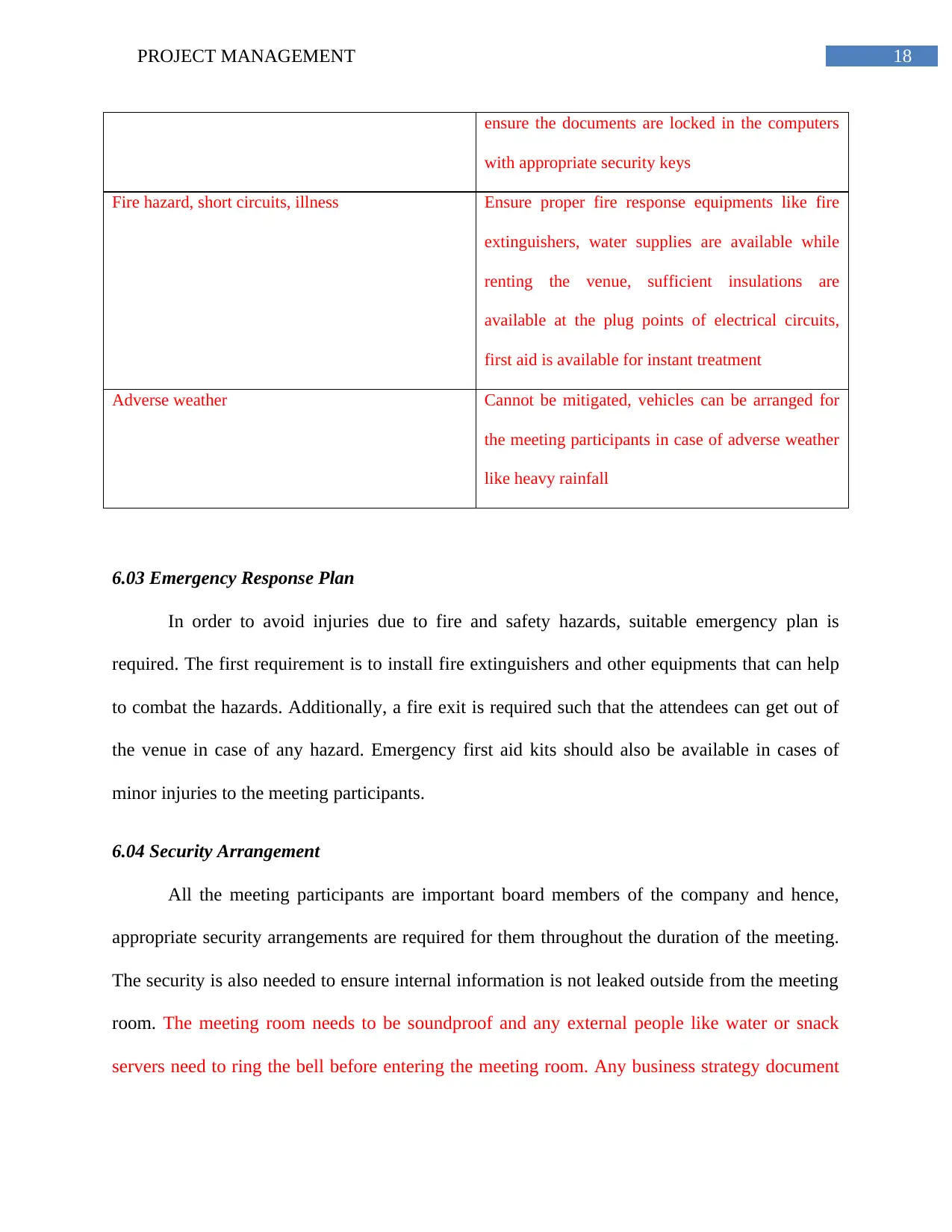
18PROJECT MANAGEMENT
ensure the documents are locked in the computers
with appropriate security keys
Fire hazard, short circuits, illness Ensure proper fire response equipments like fire
extinguishers, water supplies are available while
renting the venue, sufficient insulations are
available at the plug points of electrical circuits,
first aid is available for instant treatment
Adverse weather Cannot be mitigated, vehicles can be arranged for
the meeting participants in case of adverse weather
like heavy rainfall
6.03 Emergency Response Plan
In order to avoid injuries due to fire and safety hazards, suitable emergency plan is
required. The first requirement is to install fire extinguishers and other equipments that can help
to combat the hazards. Additionally, a fire exit is required such that the attendees can get out of
the venue in case of any hazard. Emergency first aid kits should also be available in cases of
minor injuries to the meeting participants.
6.04 Security Arrangement
All the meeting participants are important board members of the company and hence,
appropriate security arrangements are required for them throughout the duration of the meeting.
The security is also needed to ensure internal information is not leaked outside from the meeting
room. The meeting room needs to be soundproof and any external people like water or snack
servers need to ring the bell before entering the meeting room. Any business strategy document
ensure the documents are locked in the computers
with appropriate security keys
Fire hazard, short circuits, illness Ensure proper fire response equipments like fire
extinguishers, water supplies are available while
renting the venue, sufficient insulations are
available at the plug points of electrical circuits,
first aid is available for instant treatment
Adverse weather Cannot be mitigated, vehicles can be arranged for
the meeting participants in case of adverse weather
like heavy rainfall
6.03 Emergency Response Plan
In order to avoid injuries due to fire and safety hazards, suitable emergency plan is
required. The first requirement is to install fire extinguishers and other equipments that can help
to combat the hazards. Additionally, a fire exit is required such that the attendees can get out of
the venue in case of any hazard. Emergency first aid kits should also be available in cases of
minor injuries to the meeting participants.
6.04 Security Arrangement
All the meeting participants are important board members of the company and hence,
appropriate security arrangements are required for them throughout the duration of the meeting.
The security is also needed to ensure internal information is not leaked outside from the meeting
room. The meeting room needs to be soundproof and any external people like water or snack
servers need to ring the bell before entering the meeting room. Any business strategy document
Paraphrase This Document
Need a fresh take? Get an instant paraphrase of this document with our AI Paraphraser
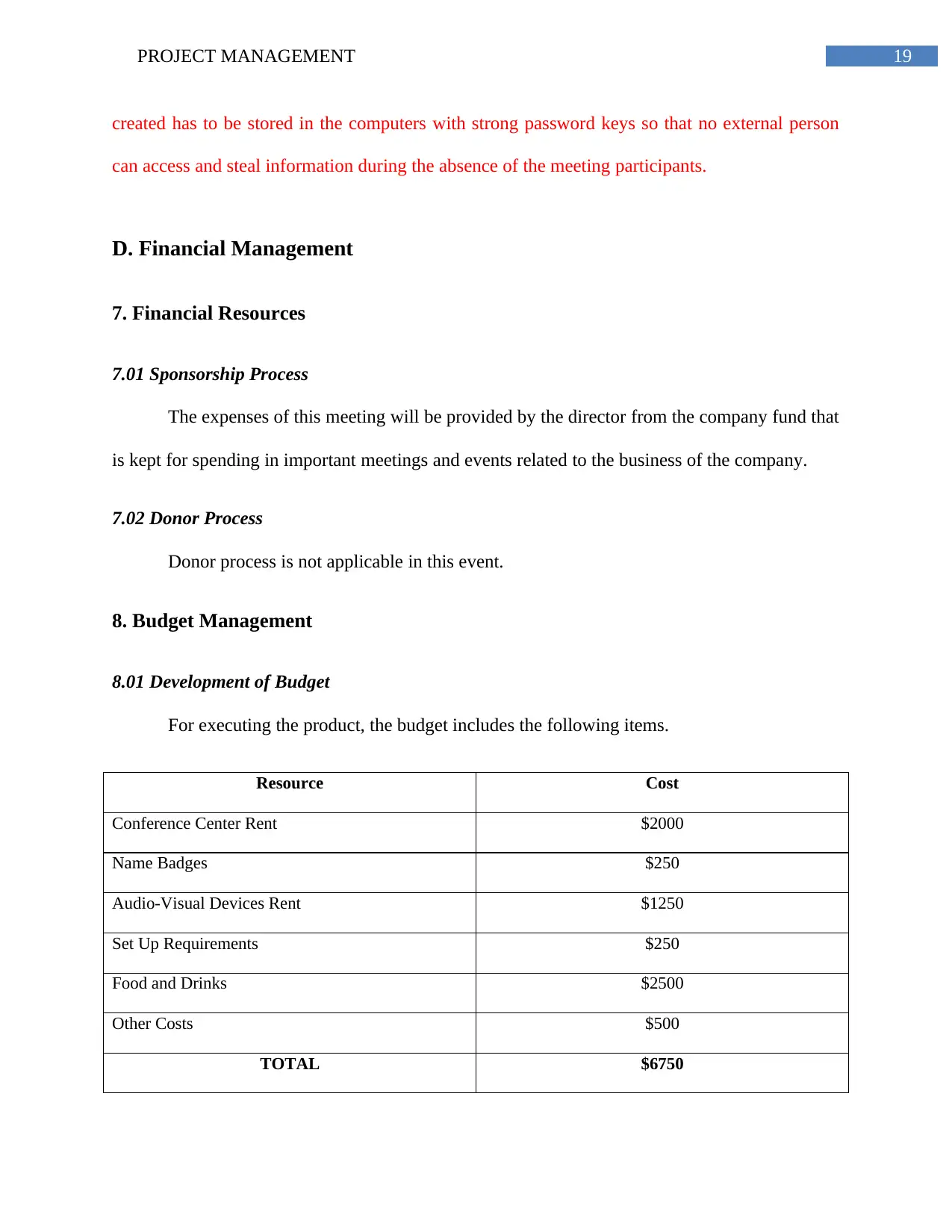
19PROJECT MANAGEMENT
created has to be stored in the computers with strong password keys so that no external person
can access and steal information during the absence of the meeting participants.
D. Financial Management
7. Financial Resources
7.01 Sponsorship Process
The expenses of this meeting will be provided by the director from the company fund that
is kept for spending in important meetings and events related to the business of the company.
7.02 Donor Process
Donor process is not applicable in this event.
8. Budget Management
8.01 Development of Budget
For executing the product, the budget includes the following items.
Resource Cost
Conference Center Rent $2000
Name Badges $250
Audio-Visual Devices Rent $1250
Set Up Requirements $250
Food and Drinks $2500
Other Costs $500
TOTAL $6750
created has to be stored in the computers with strong password keys so that no external person
can access and steal information during the absence of the meeting participants.
D. Financial Management
7. Financial Resources
7.01 Sponsorship Process
The expenses of this meeting will be provided by the director from the company fund that
is kept for spending in important meetings and events related to the business of the company.
7.02 Donor Process
Donor process is not applicable in this event.
8. Budget Management
8.01 Development of Budget
For executing the product, the budget includes the following items.
Resource Cost
Conference Center Rent $2000
Name Badges $250
Audio-Visual Devices Rent $1250
Set Up Requirements $250
Food and Drinks $2500
Other Costs $500
TOTAL $6750
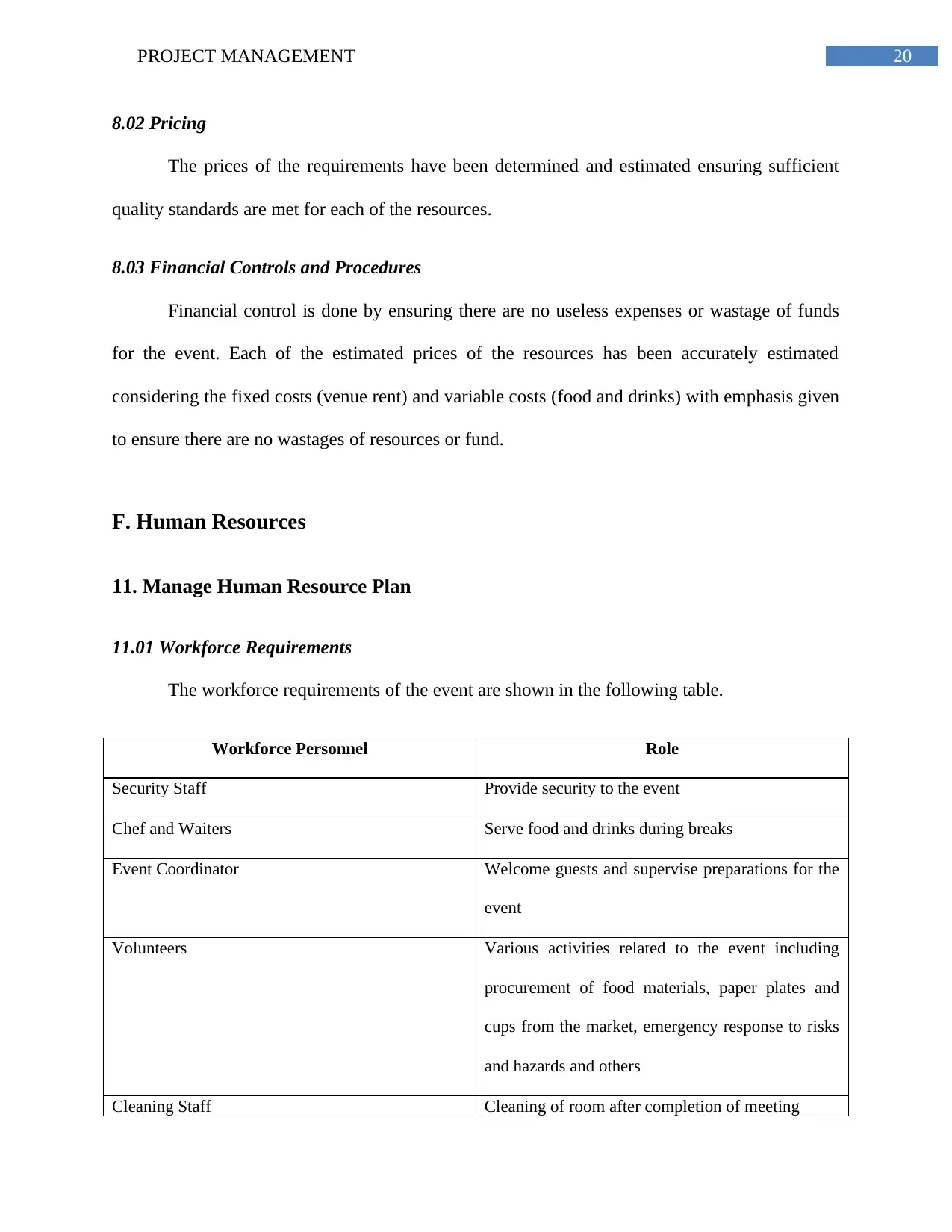
20PROJECT MANAGEMENT
8.02 Pricing
The prices of the requirements have been determined and estimated ensuring sufficient
quality standards are met for each of the resources.
8.03 Financial Controls and Procedures
Financial control is done by ensuring there are no useless expenses or wastage of funds
for the event. Each of the estimated prices of the resources has been accurately estimated
considering the fixed costs (venue rent) and variable costs (food and drinks) with emphasis given
to ensure there are no wastages of resources or fund.
F. Human Resources
11. Manage Human Resource Plan
11.01 Workforce Requirements
The workforce requirements of the event are shown in the following table.
Workforce Personnel Role
Security Staff Provide security to the event
Chef and Waiters Serve food and drinks during breaks
Event Coordinator Welcome guests and supervise preparations for the
event
Volunteers Various activities related to the event including
procurement of food materials, paper plates and
cups from the market, emergency response to risks
and hazards and others
Cleaning Staff Cleaning of room after completion of meeting
8.02 Pricing
The prices of the requirements have been determined and estimated ensuring sufficient
quality standards are met for each of the resources.
8.03 Financial Controls and Procedures
Financial control is done by ensuring there are no useless expenses or wastage of funds
for the event. Each of the estimated prices of the resources has been accurately estimated
considering the fixed costs (venue rent) and variable costs (food and drinks) with emphasis given
to ensure there are no wastages of resources or fund.
F. Human Resources
11. Manage Human Resource Plan
11.01 Workforce Requirements
The workforce requirements of the event are shown in the following table.
Workforce Personnel Role
Security Staff Provide security to the event
Chef and Waiters Serve food and drinks during breaks
Event Coordinator Welcome guests and supervise preparations for the
event
Volunteers Various activities related to the event including
procurement of food materials, paper plates and
cups from the market, emergency response to risks
and hazards and others
Cleaning Staff Cleaning of room after completion of meeting
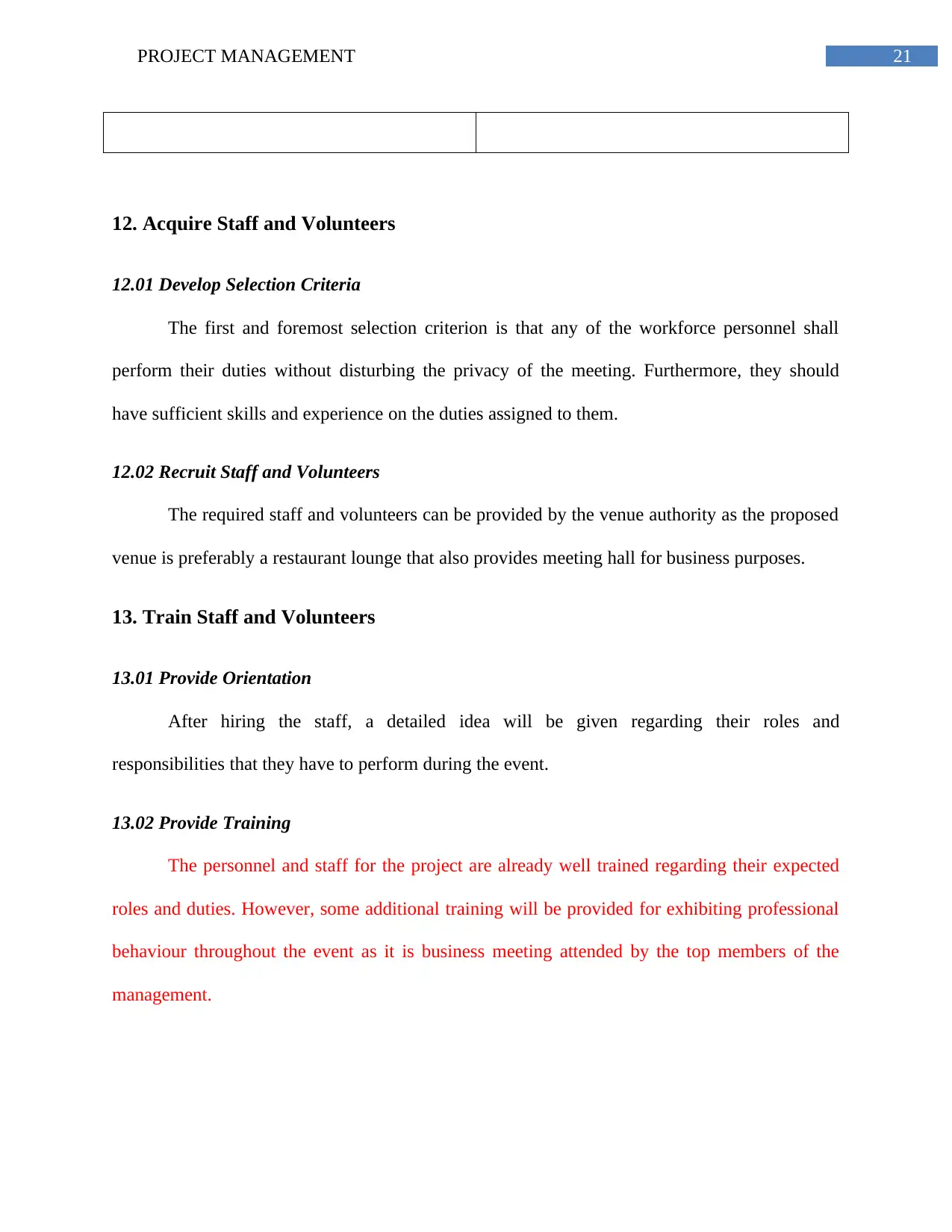
21PROJECT MANAGEMENT
12. Acquire Staff and Volunteers
12.01 Develop Selection Criteria
The first and foremost selection criterion is that any of the workforce personnel shall
perform their duties without disturbing the privacy of the meeting. Furthermore, they should
have sufficient skills and experience on the duties assigned to them.
12.02 Recruit Staff and Volunteers
The required staff and volunteers can be provided by the venue authority as the proposed
venue is preferably a restaurant lounge that also provides meeting hall for business purposes.
13. Train Staff and Volunteers
13.01 Provide Orientation
After hiring the staff, a detailed idea will be given regarding their roles and
responsibilities that they have to perform during the event.
13.02 Provide Training
The personnel and staff for the project are already well trained regarding their expected
roles and duties. However, some additional training will be provided for exhibiting professional
behaviour throughout the event as it is business meeting attended by the top members of the
management.
12. Acquire Staff and Volunteers
12.01 Develop Selection Criteria
The first and foremost selection criterion is that any of the workforce personnel shall
perform their duties without disturbing the privacy of the meeting. Furthermore, they should
have sufficient skills and experience on the duties assigned to them.
12.02 Recruit Staff and Volunteers
The required staff and volunteers can be provided by the venue authority as the proposed
venue is preferably a restaurant lounge that also provides meeting hall for business purposes.
13. Train Staff and Volunteers
13.01 Provide Orientation
After hiring the staff, a detailed idea will be given regarding their roles and
responsibilities that they have to perform during the event.
13.02 Provide Training
The personnel and staff for the project are already well trained regarding their expected
roles and duties. However, some additional training will be provided for exhibiting professional
behaviour throughout the event as it is business meeting attended by the top members of the
management.
Secure Best Marks with AI Grader
Need help grading? Try our AI Grader for instant feedback on your assignments.
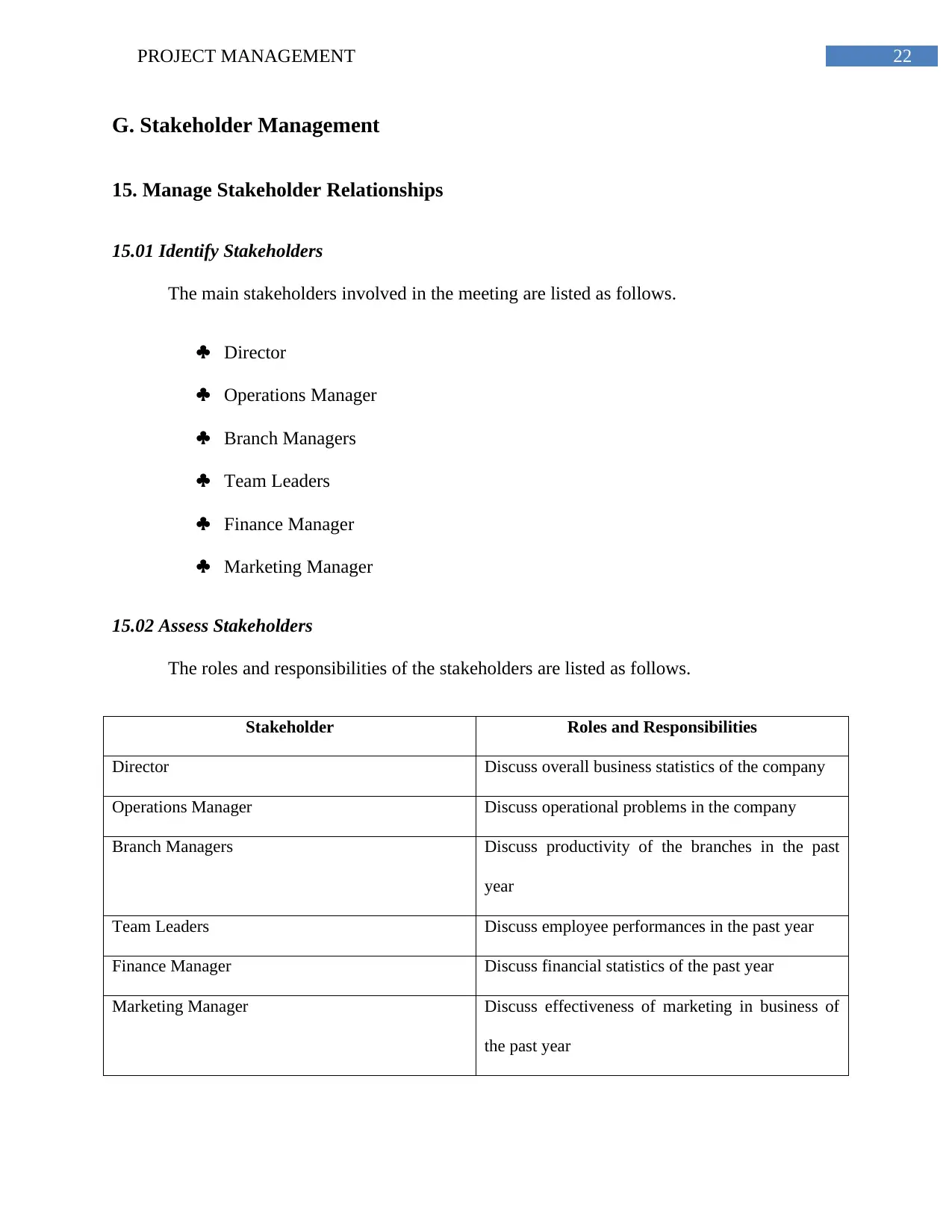
22PROJECT MANAGEMENT
G. Stakeholder Management
15. Manage Stakeholder Relationships
15.01 Identify Stakeholders
The main stakeholders involved in the meeting are listed as follows.
Director
Operations Manager
Branch Managers
Team Leaders
Finance Manager
Marketing Manager
15.02 Assess Stakeholders
The roles and responsibilities of the stakeholders are listed as follows.
Stakeholder Roles and Responsibilities
Director Discuss overall business statistics of the company
Operations Manager Discuss operational problems in the company
Branch Managers Discuss productivity of the branches in the past
year
Team Leaders Discuss employee performances in the past year
Finance Manager Discuss financial statistics of the past year
Marketing Manager Discuss effectiveness of marketing in business of
the past year
G. Stakeholder Management
15. Manage Stakeholder Relationships
15.01 Identify Stakeholders
The main stakeholders involved in the meeting are listed as follows.
Director
Operations Manager
Branch Managers
Team Leaders
Finance Manager
Marketing Manager
15.02 Assess Stakeholders
The roles and responsibilities of the stakeholders are listed as follows.
Stakeholder Roles and Responsibilities
Director Discuss overall business statistics of the company
Operations Manager Discuss operational problems in the company
Branch Managers Discuss productivity of the branches in the past
year
Team Leaders Discuss employee performances in the past year
Finance Manager Discuss financial statistics of the past year
Marketing Manager Discuss effectiveness of marketing in business of
the past year
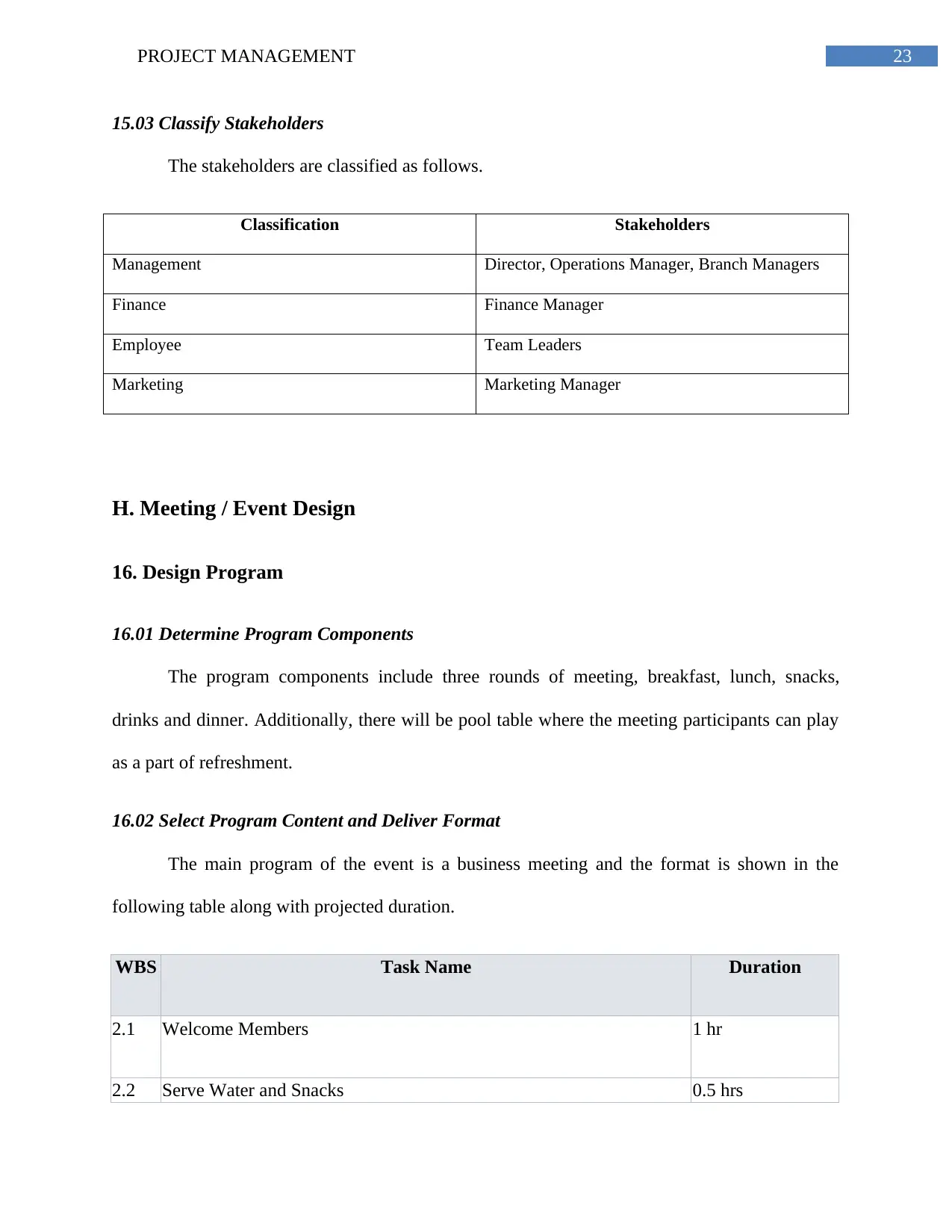
23PROJECT MANAGEMENT
15.03 Classify Stakeholders
The stakeholders are classified as follows.
Classification Stakeholders
Management Director, Operations Manager, Branch Managers
Finance Finance Manager
Employee Team Leaders
Marketing Marketing Manager
H. Meeting / Event Design
16. Design Program
16.01 Determine Program Components
The program components include three rounds of meeting, breakfast, lunch, snacks,
drinks and dinner. Additionally, there will be pool table where the meeting participants can play
as a part of refreshment.
16.02 Select Program Content and Deliver Format
The main program of the event is a business meeting and the format is shown in the
following table along with projected duration.
WBS Task Name Duration
2.1 Welcome Members 1 hr
2.2 Serve Water and Snacks 0.5 hrs
15.03 Classify Stakeholders
The stakeholders are classified as follows.
Classification Stakeholders
Management Director, Operations Manager, Branch Managers
Finance Finance Manager
Employee Team Leaders
Marketing Marketing Manager
H. Meeting / Event Design
16. Design Program
16.01 Determine Program Components
The program components include three rounds of meeting, breakfast, lunch, snacks,
drinks and dinner. Additionally, there will be pool table where the meeting participants can play
as a part of refreshment.
16.02 Select Program Content and Deliver Format
The main program of the event is a business meeting and the format is shown in the
following table along with projected duration.
WBS Task Name Duration
2.1 Welcome Members 1 hr
2.2 Serve Water and Snacks 0.5 hrs
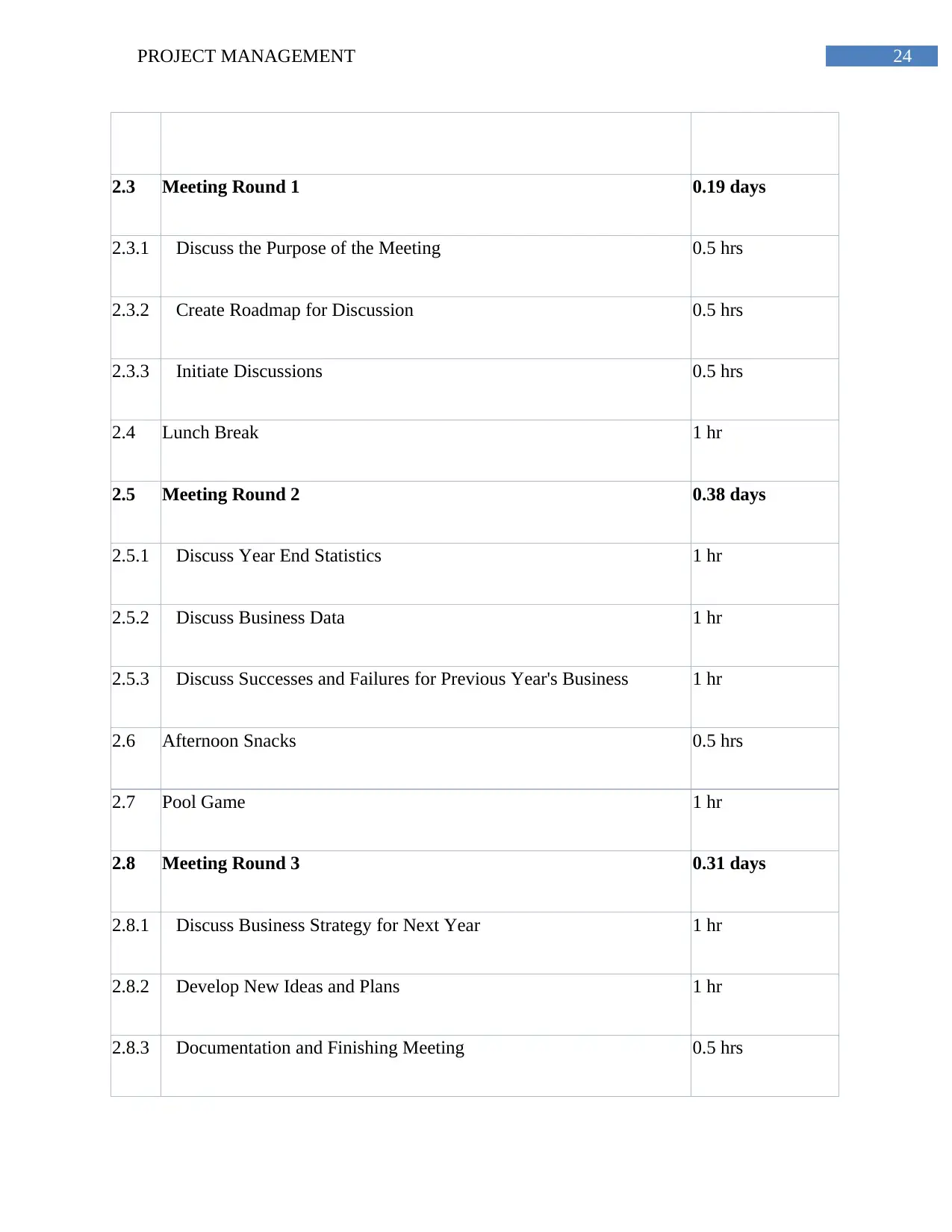
24PROJECT MANAGEMENT
2.3 Meeting Round 1 0.19 days
2.3.1 Discuss the Purpose of the Meeting 0.5 hrs
2.3.2 Create Roadmap for Discussion 0.5 hrs
2.3.3 Initiate Discussions 0.5 hrs
2.4 Lunch Break 1 hr
2.5 Meeting Round 2 0.38 days
2.5.1 Discuss Year End Statistics 1 hr
2.5.2 Discuss Business Data 1 hr
2.5.3 Discuss Successes and Failures for Previous Year's Business 1 hr
2.6 Afternoon Snacks 0.5 hrs
2.7 Pool Game 1 hr
2.8 Meeting Round 3 0.31 days
2.8.1 Discuss Business Strategy for Next Year 1 hr
2.8.2 Develop New Ideas and Plans 1 hr
2.8.3 Documentation and Finishing Meeting 0.5 hrs
2.3 Meeting Round 1 0.19 days
2.3.1 Discuss the Purpose of the Meeting 0.5 hrs
2.3.2 Create Roadmap for Discussion 0.5 hrs
2.3.3 Initiate Discussions 0.5 hrs
2.4 Lunch Break 1 hr
2.5 Meeting Round 2 0.38 days
2.5.1 Discuss Year End Statistics 1 hr
2.5.2 Discuss Business Data 1 hr
2.5.3 Discuss Successes and Failures for Previous Year's Business 1 hr
2.6 Afternoon Snacks 0.5 hrs
2.7 Pool Game 1 hr
2.8 Meeting Round 3 0.31 days
2.8.1 Discuss Business Strategy for Next Year 1 hr
2.8.2 Develop New Ideas and Plans 1 hr
2.8.3 Documentation and Finishing Meeting 0.5 hrs
Paraphrase This Document
Need a fresh take? Get an instant paraphrase of this document with our AI Paraphraser
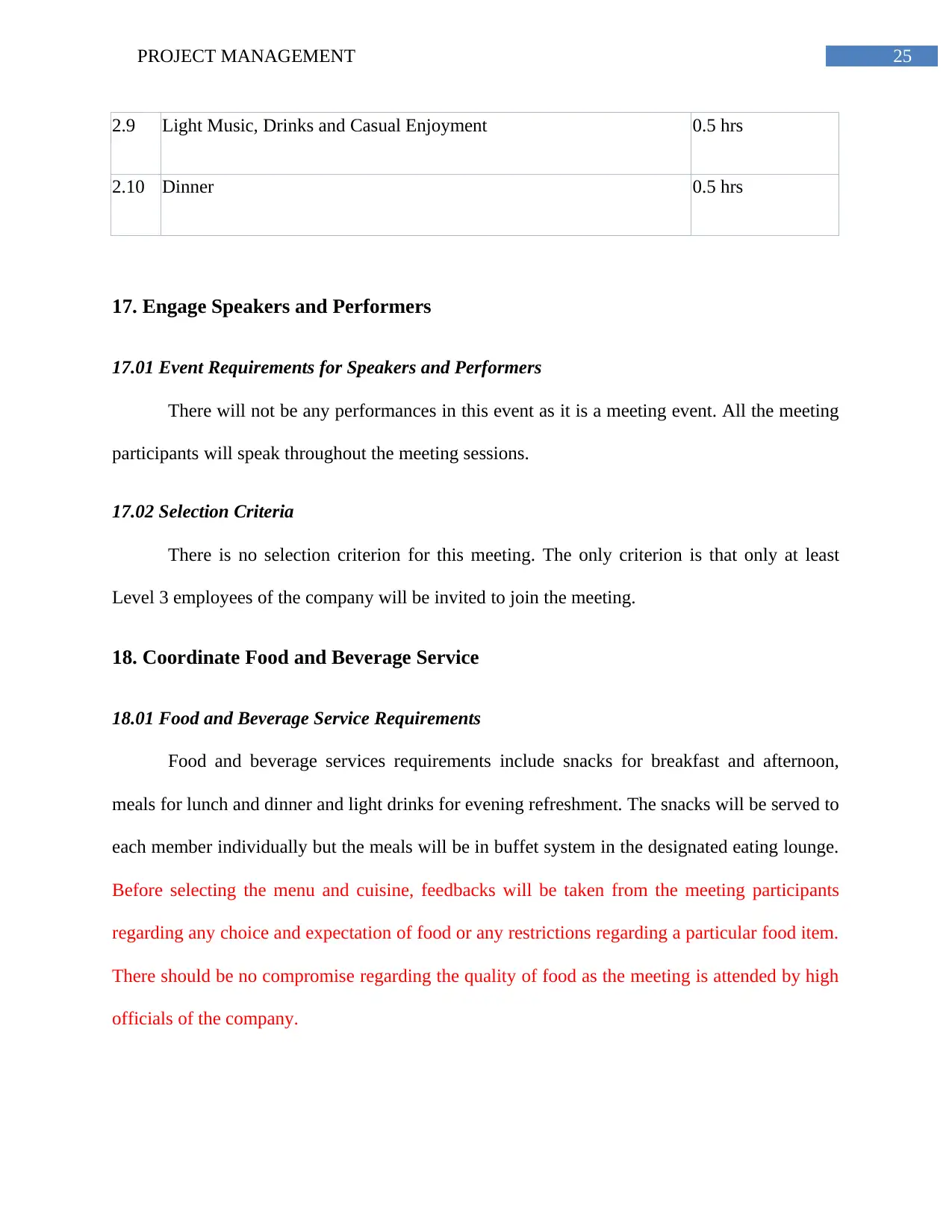
25PROJECT MANAGEMENT
2.9 Light Music, Drinks and Casual Enjoyment 0.5 hrs
2.10 Dinner 0.5 hrs
17. Engage Speakers and Performers
17.01 Event Requirements for Speakers and Performers
There will not be any performances in this event as it is a meeting event. All the meeting
participants will speak throughout the meeting sessions.
17.02 Selection Criteria
There is no selection criterion for this meeting. The only criterion is that only at least
Level 3 employees of the company will be invited to join the meeting.
18. Coordinate Food and Beverage Service
18.01 Food and Beverage Service Requirements
Food and beverage services requirements include snacks for breakfast and afternoon,
meals for lunch and dinner and light drinks for evening refreshment. The snacks will be served to
each member individually but the meals will be in buffet system in the designated eating lounge.
Before selecting the menu and cuisine, feedbacks will be taken from the meeting participants
regarding any choice and expectation of food or any restrictions regarding a particular food item.
There should be no compromise regarding the quality of food as the meeting is attended by high
officials of the company.
2.9 Light Music, Drinks and Casual Enjoyment 0.5 hrs
2.10 Dinner 0.5 hrs
17. Engage Speakers and Performers
17.01 Event Requirements for Speakers and Performers
There will not be any performances in this event as it is a meeting event. All the meeting
participants will speak throughout the meeting sessions.
17.02 Selection Criteria
There is no selection criterion for this meeting. The only criterion is that only at least
Level 3 employees of the company will be invited to join the meeting.
18. Coordinate Food and Beverage Service
18.01 Food and Beverage Service Requirements
Food and beverage services requirements include snacks for breakfast and afternoon,
meals for lunch and dinner and light drinks for evening refreshment. The snacks will be served to
each member individually but the meals will be in buffet system in the designated eating lounge.
Before selecting the menu and cuisine, feedbacks will be taken from the meeting participants
regarding any choice and expectation of food or any restrictions regarding a particular food item.
There should be no compromise regarding the quality of food as the meeting is attended by high
officials of the company.

26PROJECT MANAGEMENT
18.02 Select Menu
Standard venue menu is chosen to avoid confusion among the meeting participants and
there will be no dietary restrictions or cultural considerations for the food and beverage.
18.03 Plan Service Style
The snacks will be served to each member individually but the meals will be in buffet
system in the designated eating lounge.
18.04 Select Food and Beverage Provider
The venue manager will provide food and beverage services as per the venue’s standard
menu available.
19. Design Environment
19.01 Establish Function Requirements
The functional requirements of the event include audio-visual equipment and technical
devices like projector, projection screen, laptops, internet connection and other utilities.
19.02 Select Décor and Furnishings
This is not a festival type event and hence, décor is not essentially necessary for this
event. Furnishing requirement includes round table desk and comfort chairs where the
participants will sit and discuss throughout the meeting.
20. Manage Technical Production
20.01 Determine Requirements for Staging and Technical Equipment
Staging is not required in this event.
18.02 Select Menu
Standard venue menu is chosen to avoid confusion among the meeting participants and
there will be no dietary restrictions or cultural considerations for the food and beverage.
18.03 Plan Service Style
The snacks will be served to each member individually but the meals will be in buffet
system in the designated eating lounge.
18.04 Select Food and Beverage Provider
The venue manager will provide food and beverage services as per the venue’s standard
menu available.
19. Design Environment
19.01 Establish Function Requirements
The functional requirements of the event include audio-visual equipment and technical
devices like projector, projection screen, laptops, internet connection and other utilities.
19.02 Select Décor and Furnishings
This is not a festival type event and hence, décor is not essentially necessary for this
event. Furnishing requirement includes round table desk and comfort chairs where the
participants will sit and discuss throughout the meeting.
20. Manage Technical Production
20.01 Determine Requirements for Staging and Technical Equipment
Staging is not required in this event.
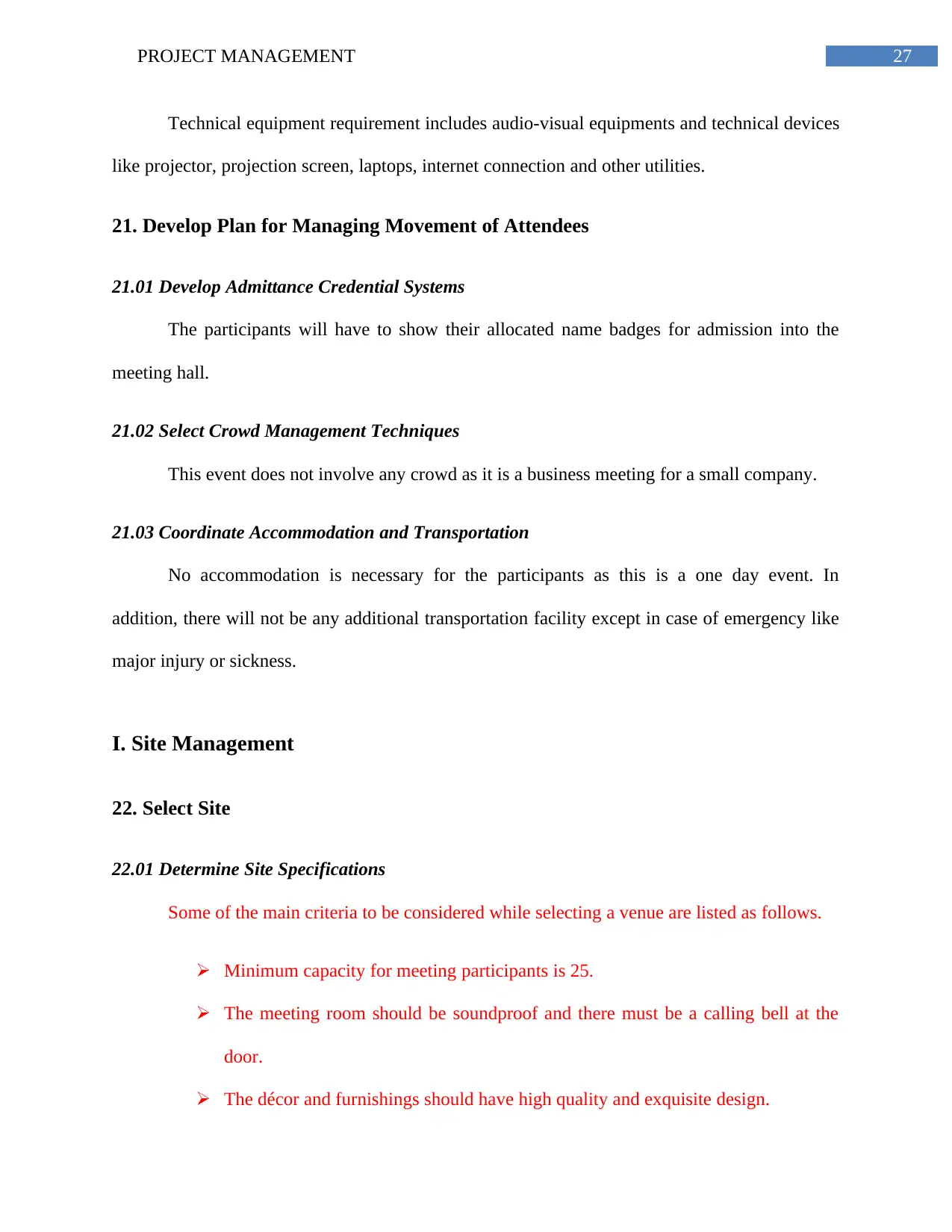
27PROJECT MANAGEMENT
Technical equipment requirement includes audio-visual equipments and technical devices
like projector, projection screen, laptops, internet connection and other utilities.
21. Develop Plan for Managing Movement of Attendees
21.01 Develop Admittance Credential Systems
The participants will have to show their allocated name badges for admission into the
meeting hall.
21.02 Select Crowd Management Techniques
This event does not involve any crowd as it is a business meeting for a small company.
21.03 Coordinate Accommodation and Transportation
No accommodation is necessary for the participants as this is a one day event. In
addition, there will not be any additional transportation facility except in case of emergency like
major injury or sickness.
I. Site Management
22. Select Site
22.01 Determine Site Specifications
Some of the main criteria to be considered while selecting a venue are listed as follows.
Minimum capacity for meeting participants is 25.
The meeting room should be soundproof and there must be a calling bell at the
door.
The décor and furnishings should have high quality and exquisite design.
Technical equipment requirement includes audio-visual equipments and technical devices
like projector, projection screen, laptops, internet connection and other utilities.
21. Develop Plan for Managing Movement of Attendees
21.01 Develop Admittance Credential Systems
The participants will have to show their allocated name badges for admission into the
meeting hall.
21.02 Select Crowd Management Techniques
This event does not involve any crowd as it is a business meeting for a small company.
21.03 Coordinate Accommodation and Transportation
No accommodation is necessary for the participants as this is a one day event. In
addition, there will not be any additional transportation facility except in case of emergency like
major injury or sickness.
I. Site Management
22. Select Site
22.01 Determine Site Specifications
Some of the main criteria to be considered while selecting a venue are listed as follows.
Minimum capacity for meeting participants is 25.
The meeting room should be soundproof and there must be a calling bell at the
door.
The décor and furnishings should have high quality and exquisite design.
Secure Best Marks with AI Grader
Need help grading? Try our AI Grader for instant feedback on your assignments.
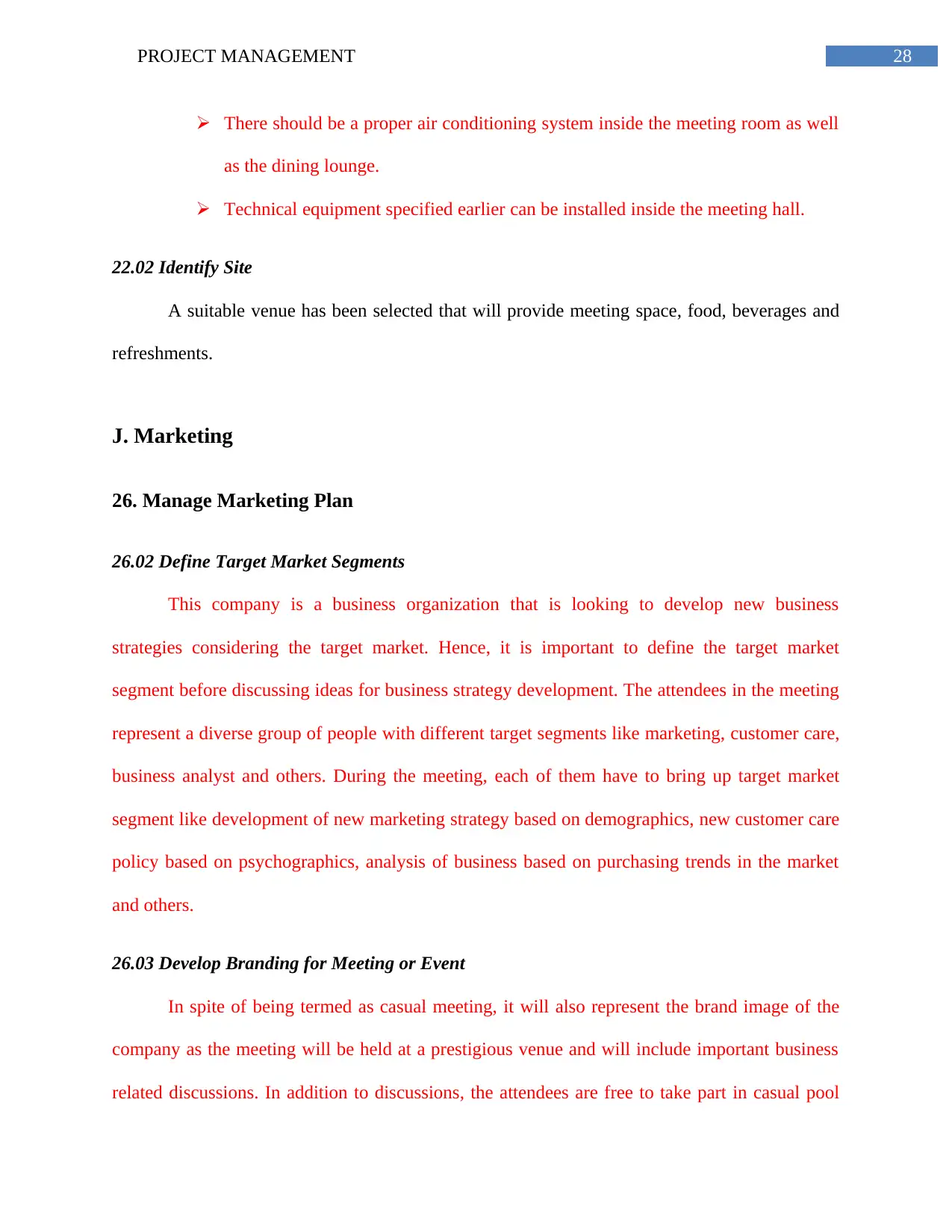
28PROJECT MANAGEMENT
There should be a proper air conditioning system inside the meeting room as well
as the dining lounge.
Technical equipment specified earlier can be installed inside the meeting hall.
22.02 Identify Site
A suitable venue has been selected that will provide meeting space, food, beverages and
refreshments.
J. Marketing
26. Manage Marketing Plan
26.02 Define Target Market Segments
This company is a business organization that is looking to develop new business
strategies considering the target market. Hence, it is important to define the target market
segment before discussing ideas for business strategy development. The attendees in the meeting
represent a diverse group of people with different target segments like marketing, customer care,
business analyst and others. During the meeting, each of them have to bring up target market
segment like development of new marketing strategy based on demographics, new customer care
policy based on psychographics, analysis of business based on purchasing trends in the market
and others.
26.03 Develop Branding for Meeting or Event
In spite of being termed as casual meeting, it will also represent the brand image of the
company as the meeting will be held at a prestigious venue and will include important business
related discussions. In addition to discussions, the attendees are free to take part in casual pool
There should be a proper air conditioning system inside the meeting room as well
as the dining lounge.
Technical equipment specified earlier can be installed inside the meeting hall.
22.02 Identify Site
A suitable venue has been selected that will provide meeting space, food, beverages and
refreshments.
J. Marketing
26. Manage Marketing Plan
26.02 Define Target Market Segments
This company is a business organization that is looking to develop new business
strategies considering the target market. Hence, it is important to define the target market
segment before discussing ideas for business strategy development. The attendees in the meeting
represent a diverse group of people with different target segments like marketing, customer care,
business analyst and others. During the meeting, each of them have to bring up target market
segment like development of new marketing strategy based on demographics, new customer care
policy based on psychographics, analysis of business based on purchasing trends in the market
and others.
26.03 Develop Branding for Meeting or Event
In spite of being termed as casual meeting, it will also represent the brand image of the
company as the meeting will be held at a prestigious venue and will include important business
related discussions. In addition to discussions, the attendees are free to take part in casual pool

29PROJECT MANAGEMENT
games for relaxation. The attendees can also participate in light dance after the meeting is over
and freely communicate with each other outside office-related discussions. Each participant will
also be provided with special watches with company logo printed on it for participating in the
meeting.
26.05 Develop Integrated Marketing Strategy
This meeting is not focused on marketing. It will just focus on business strategies for the
next year.
27. Manage Marketing Material
27.01 Determine Marketing Materials Needed for Event
No marketing materials are required for the event.
29. Promote Meeting or Event
29.01 Develop Advertising Plan
Advertising is not necessary for this project. The required participants will be sent an
invitation for joining on the meeting and the invitation card will include details like date, time
and venue of the meeting. The attendees can provide a feedback regarding requirements for
accommodation of disabilities, religious requirements, dietary restrictions, food allergies and
other relevant information for the meeting.
games for relaxation. The attendees can also participate in light dance after the meeting is over
and freely communicate with each other outside office-related discussions. Each participant will
also be provided with special watches with company logo printed on it for participating in the
meeting.
26.05 Develop Integrated Marketing Strategy
This meeting is not focused on marketing. It will just focus on business strategies for the
next year.
27. Manage Marketing Material
27.01 Determine Marketing Materials Needed for Event
No marketing materials are required for the event.
29. Promote Meeting or Event
29.01 Develop Advertising Plan
Advertising is not necessary for this project. The required participants will be sent an
invitation for joining on the meeting and the invitation card will include details like date, time
and venue of the meeting. The attendees can provide a feedback regarding requirements for
accommodation of disabilities, religious requirements, dietary restrictions, food allergies and
other relevant information for the meeting.
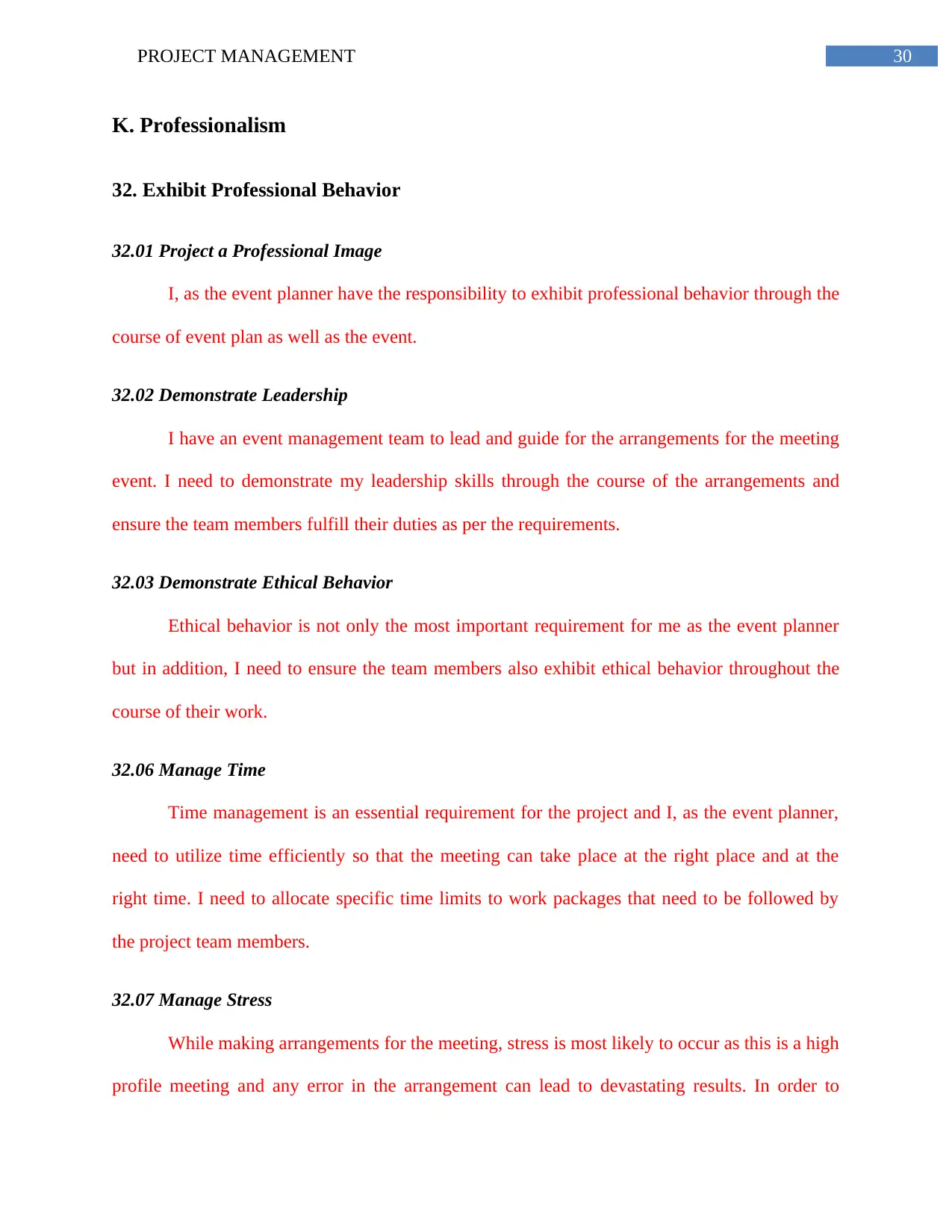
30PROJECT MANAGEMENT
K. Professionalism
32. Exhibit Professional Behavior
32.01 Project a Professional Image
I, as the event planner have the responsibility to exhibit professional behavior through the
course of event plan as well as the event.
32.02 Demonstrate Leadership
I have an event management team to lead and guide for the arrangements for the meeting
event. I need to demonstrate my leadership skills through the course of the arrangements and
ensure the team members fulfill their duties as per the requirements.
32.03 Demonstrate Ethical Behavior
Ethical behavior is not only the most important requirement for me as the event planner
but in addition, I need to ensure the team members also exhibit ethical behavior throughout the
course of their work.
32.06 Manage Time
Time management is an essential requirement for the project and I, as the event planner,
need to utilize time efficiently so that the meeting can take place at the right place and at the
right time. I need to allocate specific time limits to work packages that need to be followed by
the project team members.
32.07 Manage Stress
While making arrangements for the meeting, stress is most likely to occur as this is a high
profile meeting and any error in the arrangement can lead to devastating results. In order to
K. Professionalism
32. Exhibit Professional Behavior
32.01 Project a Professional Image
I, as the event planner have the responsibility to exhibit professional behavior through the
course of event plan as well as the event.
32.02 Demonstrate Leadership
I have an event management team to lead and guide for the arrangements for the meeting
event. I need to demonstrate my leadership skills through the course of the arrangements and
ensure the team members fulfill their duties as per the requirements.
32.03 Demonstrate Ethical Behavior
Ethical behavior is not only the most important requirement for me as the event planner
but in addition, I need to ensure the team members also exhibit ethical behavior throughout the
course of their work.
32.06 Manage Time
Time management is an essential requirement for the project and I, as the event planner,
need to utilize time efficiently so that the meeting can take place at the right place and at the
right time. I need to allocate specific time limits to work packages that need to be followed by
the project team members.
32.07 Manage Stress
While making arrangements for the meeting, stress is most likely to occur as this is a high
profile meeting and any error in the arrangement can lead to devastating results. In order to
Paraphrase This Document
Need a fresh take? Get an instant paraphrase of this document with our AI Paraphraser

31PROJECT MANAGEMENT
manage stress, I need to follow a systematic approach towards my work responsibilities but also
emphasize on not having to over-commit or work overtime for arranging the meeting. Team
approach instead of individual work is one way to reduce stress and complete tasks effectively.
manage stress, I need to follow a systematic approach towards my work responsibilities but also
emphasize on not having to over-commit or work overtime for arranging the meeting. Team
approach instead of individual work is one way to reduce stress and complete tasks effectively.
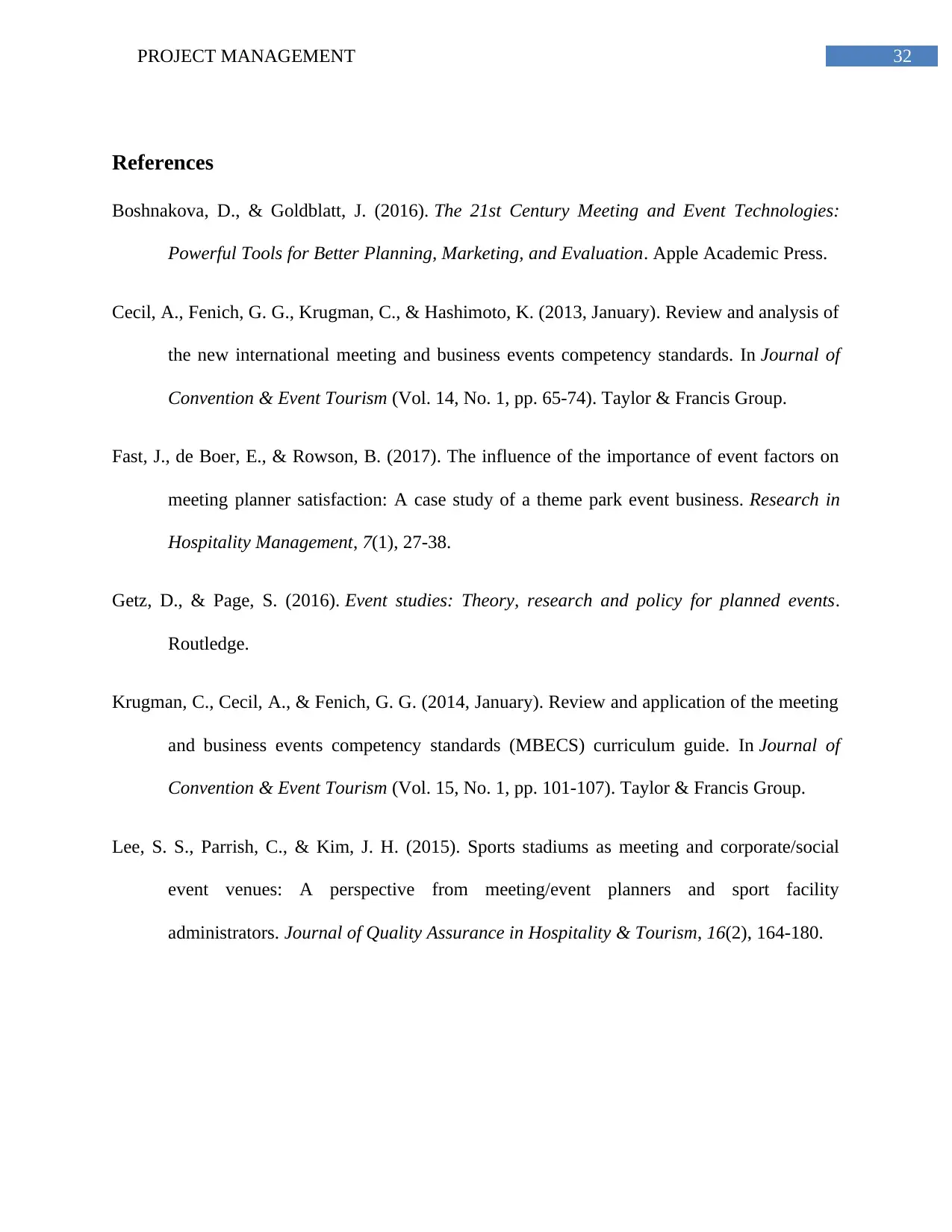
32PROJECT MANAGEMENT
References
Boshnakova, D., & Goldblatt, J. (2016). The 21st Century Meeting and Event Technologies:
Powerful Tools for Better Planning, Marketing, and Evaluation. Apple Academic Press.
Cecil, A., Fenich, G. G., Krugman, C., & Hashimoto, K. (2013, January). Review and analysis of
the new international meeting and business events competency standards. In Journal of
Convention & Event Tourism (Vol. 14, No. 1, pp. 65-74). Taylor & Francis Group.
Fast, J., de Boer, E., & Rowson, B. (2017). The influence of the importance of event factors on
meeting planner satisfaction: A case study of a theme park event business. Research in
Hospitality Management, 7(1), 27-38.
Getz, D., & Page, S. (2016). Event studies: Theory, research and policy for planned events.
Routledge.
Krugman, C., Cecil, A., & Fenich, G. G. (2014, January). Review and application of the meeting
and business events competency standards (MBECS) curriculum guide. In Journal of
Convention & Event Tourism (Vol. 15, No. 1, pp. 101-107). Taylor & Francis Group.
Lee, S. S., Parrish, C., & Kim, J. H. (2015). Sports stadiums as meeting and corporate/social
event venues: A perspective from meeting/event planners and sport facility
administrators. Journal of Quality Assurance in Hospitality & Tourism, 16(2), 164-180.
References
Boshnakova, D., & Goldblatt, J. (2016). The 21st Century Meeting and Event Technologies:
Powerful Tools for Better Planning, Marketing, and Evaluation. Apple Academic Press.
Cecil, A., Fenich, G. G., Krugman, C., & Hashimoto, K. (2013, January). Review and analysis of
the new international meeting and business events competency standards. In Journal of
Convention & Event Tourism (Vol. 14, No. 1, pp. 65-74). Taylor & Francis Group.
Fast, J., de Boer, E., & Rowson, B. (2017). The influence of the importance of event factors on
meeting planner satisfaction: A case study of a theme park event business. Research in
Hospitality Management, 7(1), 27-38.
Getz, D., & Page, S. (2016). Event studies: Theory, research and policy for planned events.
Routledge.
Krugman, C., Cecil, A., & Fenich, G. G. (2014, January). Review and application of the meeting
and business events competency standards (MBECS) curriculum guide. In Journal of
Convention & Event Tourism (Vol. 15, No. 1, pp. 101-107). Taylor & Francis Group.
Lee, S. S., Parrish, C., & Kim, J. H. (2015). Sports stadiums as meeting and corporate/social
event venues: A perspective from meeting/event planners and sport facility
administrators. Journal of Quality Assurance in Hospitality & Tourism, 16(2), 164-180.
1 out of 33
Related Documents
Your All-in-One AI-Powered Toolkit for Academic Success.
+13062052269
info@desklib.com
Available 24*7 on WhatsApp / Email
![[object Object]](/_next/static/media/star-bottom.7253800d.svg)
Unlock your academic potential
© 2024 | Zucol Services PVT LTD | All rights reserved.





